Merrion Square
Dublin, Ireland
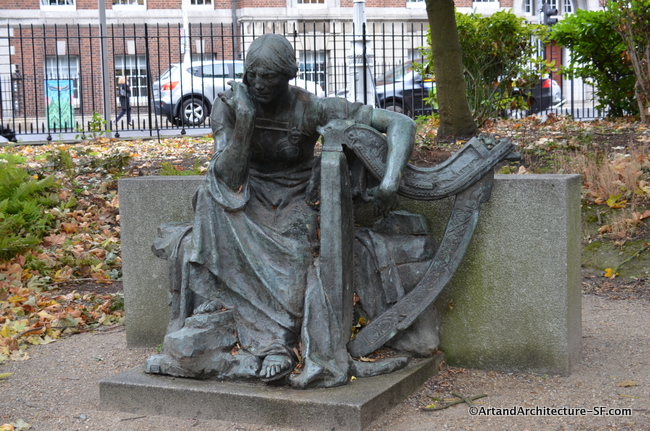 Éire by Jerome Connor
Éire by Jerome Connor
Jerome Connor (February 1874 – August 1943) was born in Coumduff, Annascaul, Ireland. He was the sixth and youngest son of Patrick and Margaret Connor.
The family moved to Holyoake, Massachusetts in the 1890s.
Jerome ran away from home and settled in New York. After trying many trades (foundry-man, professional prize fighter, machinist, sign painter, Japanese intelligence officer in Mexico, and stonecutter) he became a sculptor.
His most notable sculptures are in Washington D.C.: statues of Robert Emmett (a cast of which is in Dublin) and Bishop John Carroll, and the Nuns of the Battlefield tablet.
When the Irish Free State achieved independence in 1922, Connor returned to Ireland
In 1925 he won a prestigious commission from a New York committee to create a monument in Cobh, County Cork to commemorate the lives lost in the sinking of the Lusitania. Sadly, eighteen years later, at the time of his death, the project had not been completed. Connor had become a bankrupt and alcoholic, and died in a Dublin slum at the age of 67. The Lusitania Monument was eventually completed by another artist.
In 1928 Jerome Connor became involved in a proposal to create a memorial to the Kerry poets, which was to commemorate four leading Gaelic poets of the 17th and 18th centuries. He chose a figure of Éire holding a harp seated on a rock, possibly inspired by Walt Whitman’s poem Old Ireland in Leaves of Grass (1861). The unstrung harp was based on the 1621 Cloyne harp in the National Museum. The work went as far as a full-scale replica in wax.
Éire was cast in bronze in Dublin many years after Connor’s death. It was erected in Merrion Square, without a title or an acknowledgment of the sculptor. It has a plaque inscribed “This statue was presented by Joseph Downes and Son Ltd. in Dec. 1976 to commemorate the centenary of the ButterCrust Bakery, Dublin”.
Transbay Terminal
2nd and Folsom
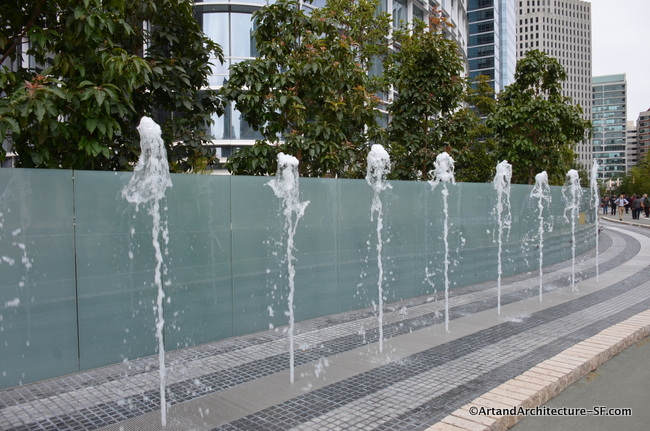
Bay Area artist Ned Kahn has been in this site before. He lived in San Francisco for over 20 years, many of which were spent designing educational exhibits at the Exploratorium. He recently moved to Sebastopol in Sonoma County to expand his studies and laboratory space.
Mr. Kahn’s work is a seamless synthesis of nature, art and technology. With extraordinary technical ability, he demonstrates the versatility of turbulent systems, such as the vortices of wind and water. His dazzlingly complex but comprehendible images of nature respond to viewers, conform to architectural structures, and reveal and make visible inherent environmental conditions.
For the Transit Center, Mr. Kahn will installed a series of water jets on the rooftop park that are triggered by sensors that respond to the vibrations of the flow of buses on the deck below. The frequency, motion and height of the jets will correspond to the level of activity on the bus deck, making the arrivals and departures of the buses visible and tangible through their choreographed effect on the water.

The Transbay Joint Power Authority (TJPA) committed $4.75 million to fund the acquisition of artwork for the program. The TJPA’s commitment is in the spirit of the city and county of San Francisco’s “Percent for Art Ordinance,” which allocates two percent of construction costs for the inclusion of public art in the civic structures and facilities, and is consistent with policies established by the Federal Transportation Authority encouraging the inclusion of art in transportation facilities.
TJPA engaged the San Francisco Arts Commission to manage and oversee the planning and development of the public art program.
The budget for this project was $378,300.
Kaiser Permanente
French Campus
4131 Geary Boulevard
Inner Richmond
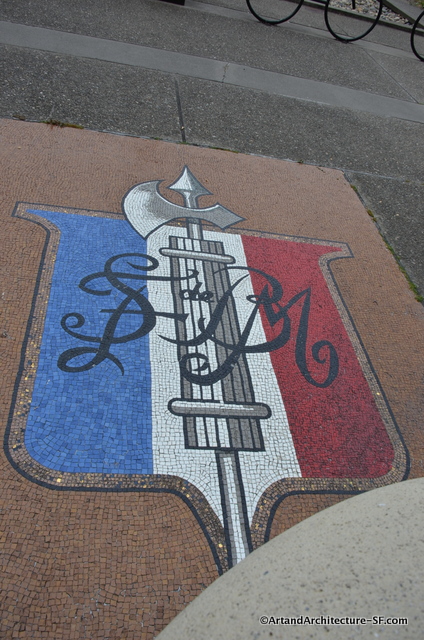
This stunning mosaic sits in the front entry way to 4131 Geary, which is a building tucked behind the main hospital wing. It is presently half covered by an extremely large concrete pot.
It was donated by the woman’s auxilary in memory of Dorothy Hagar Rogers, who was a prominent woman in the city of San Francisco known for her charitable works. She organized the Auxiliary for the French Hospital and earned the Woman of Distinction spot in the City and County Record in August of 1955.
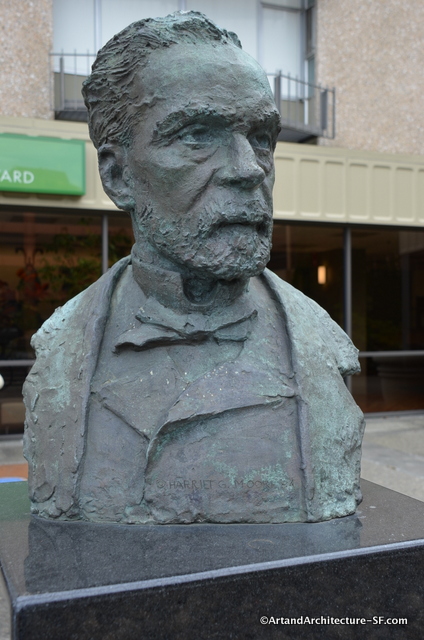
This bronze bust of Louis Pasteur that sits in the front of the building was designed by Harriet G. Moore and cast in 1984 by Artworks Foundry of Berkeley.
Moore was born in New York City in 1920. As a child, she was strongly encouraged to pursue her interest in sculpting and attended private progressive schools with a heavy emphasis on the arts. From 1938 to 1942, she attended Bennington College in Vermont, majoring in sculpture.
She spent a nonresident junior year in Mexico City, studying stone carving with Luis Ortiz Monasterio. After graduating from Bennington, she studied modeling the figure and portrait with Jose de Creft at the Art Students League in New York City.
In 1976, she moved to San Francisco and retired due to health reasons in 2010.
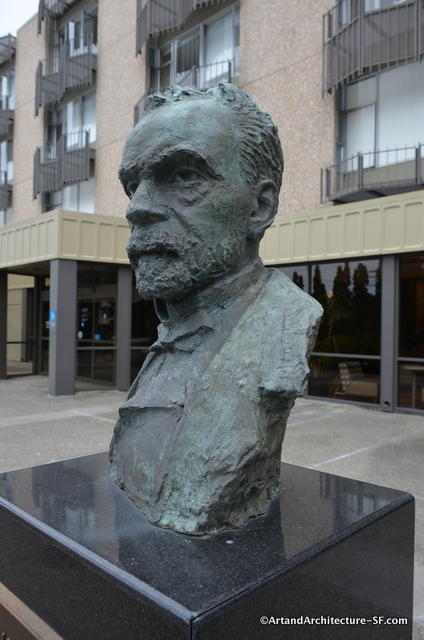
The third piece of art at 4131 Geary is a lovely mural in the lobby.
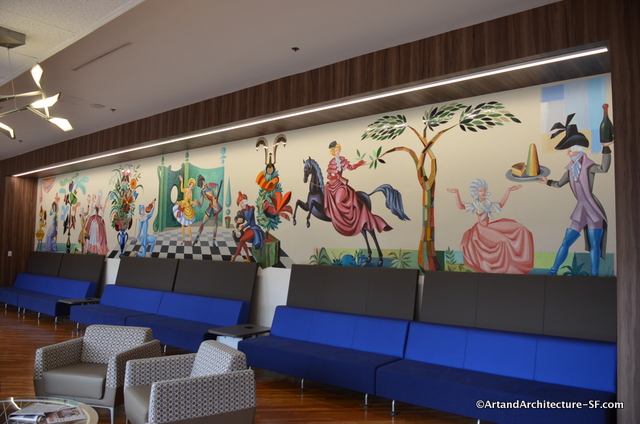
The artists of both the mosaic and the mural have been lost to time.
Laguna Honda Hospital
375 Laguna Honda Boulevard
Foresthill

Tile by Cheonae Kim
In the aqua therapy center there are two pools surrounded by walls covered in geometric patterns of ceramic tile designed by Cheonae Kim.
Cheonae Kim was born in Ichon, Korea in 1952. She graduated from Ewha Women’s University in Seoul and then went on to Southern Illinois University to receive her BA in Drawing in 1983 and her MFA in Drawing and Painting in 1986. She is a professor at the same college. Major exhibitions include Milwaukee Museum, UCLA Hammer Museum, the Rockford Museum, and the Chicago Cultural Center.
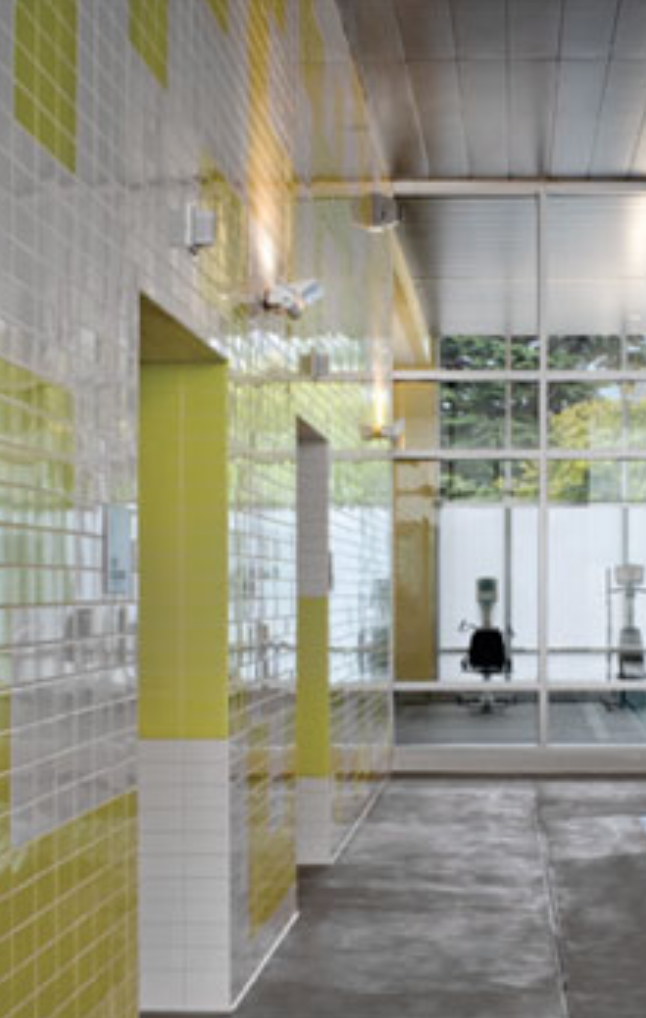
The overall budget for the artwork within the new Laguna Honda Hospital wing was $3million, thanks to the 1% for Art Program.
The budget for this tile work was $68,761.
Unity Plaza
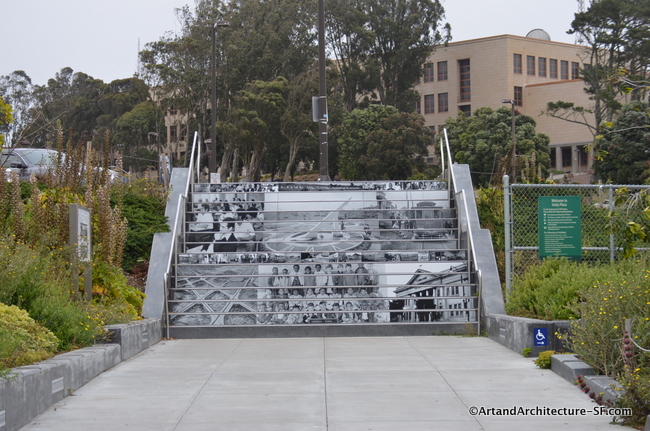
Opened in 2016 Unity Plaza features a new pedestrian path that stretches from the north side of Ocean Avenue to the City College campus. The path, created in partnership with City College, features an integrated landscape and this stairway that features a collage of historic photographs of the neighborhood laid out on the steps.

In 2009, the Balboa Park Station Area Plan was adopted by the City and County of San Francisco. This was the culmination of a 10 year Better Neighborhoods Planning Process.
The plan also included a reconfiguration of the Phelan Bus Loop, now known as City College Terminal and the affordable housing project on 1100 Ocean Ave. Unity Plaza occupies the space between the bus loop and the housing development.
Some of the larger scenes in the stairway consist of:
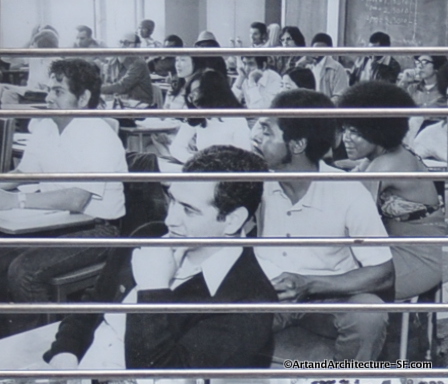 City College students, taken in 1973
City College students, taken in 1973
 The Sundial at Ingleside Terrace
The Sundial at Ingleside Terrace
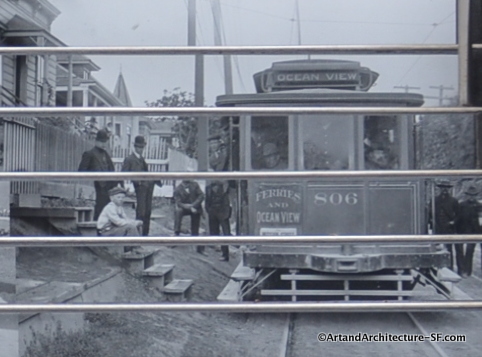 Street Cars
Street Cars
 The Rail and Streetcar Intersection in 1904
The Rail and Streetcar Intersection in 1904
 The Ingleside Presbyterian Church founded in 1907
The Ingleside Presbyterian Church founded in 1907
The project was created by Wowhaus Studios who have been in this site before. They are photographs printed on porcelain enamel tiles and installed in the risers. Wowhaus sourced the images directly from community members and the library archives.
This was paid for by the San Francisco Arts Commission with a budget not to exceed $15,000.
Palace of Fine Arts
Location now: Unknown

Robert Reid working on the Palace of Fine Arts murals Photo: Smithsonian
In keeping with the mission of this website to catalog all art owned by the San Francisco Art Commission, we would be remiss if we did not include one of the greater pieces of art from the Golden Gate International Exposition, that has been lost.
Robert Lewis Reid’s murals for the Palace of Fine Arts building at the Panama–Pacific International Exposition in San Francisco, in 1915 was an extraordinary tribute to the Arts. Eight huge panels graced the ceiling of the rotunda: The Four Golds of California (Golden Metal, Wheat, Citrus Fruits, and Poppies); plus Ideals in Art, Inspirations of All Arts, the Birth of European Art and Birth of Oriental Art. San Francisco’s Palace of Fine Arts was re-built in the 1960s and these paintings no longer exist.
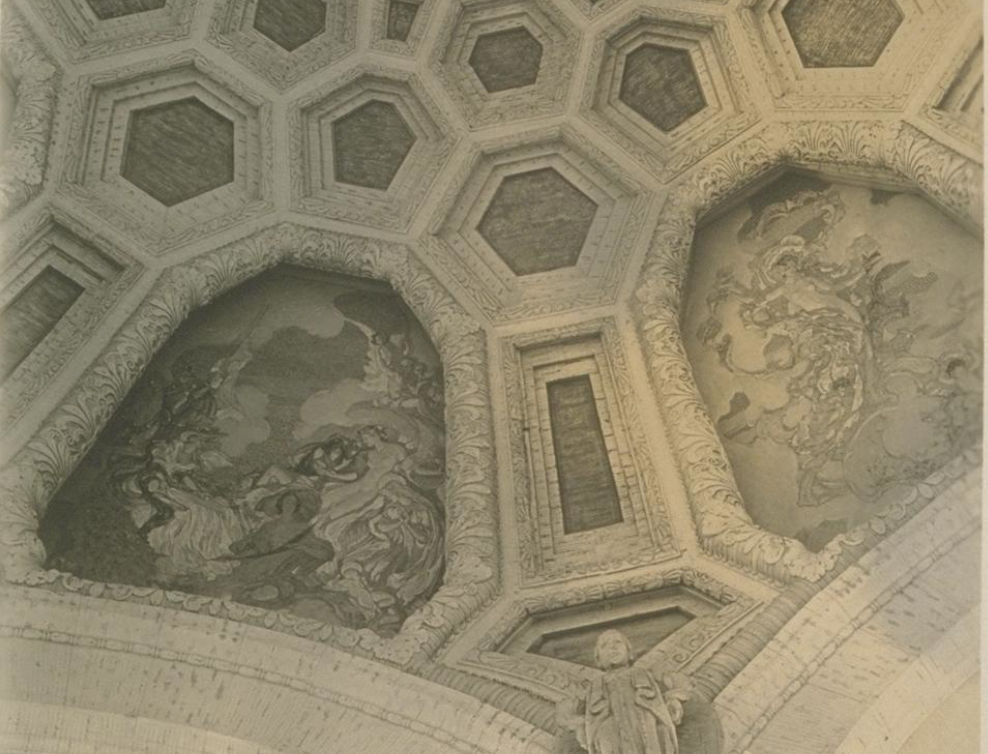
From The Jewel City Chapter 12: Above, in the dome, Robert Reid’s eight murals, splendid in color, are too far away to be seen well as pictures. Two separate series are alternated, one symbolizing the Progress of Art, the other depicting the Four Golds of California. The panel in the east, nearest the altar, is “The Birth of European Art.” The sacred fire burns on an altar, beside which stands the guardian holding out the torch of inspiration to an earthly messenger who leans from his chariot to receive it. On the right is the Orange panel, representing one of the California golds.
“Inspiration in All Art” comes next. The veil of darkness, drawn back, reveals the arts: Music, Painting, Poetry, and Sculpture. A winged figure bears the torch of inspiration. The second of the California golds, the Wheat panel, follows, and then “The Birth of Oriental Art.” The allegory here is the ancient Ming legend of the forces of earth trying to wrest inspiration from the powers of air. A Chinese warrior mounted on a dragon struggles with an eagle.
Gold, the yellow metal, is the subject of the next panel, followed by “Ideals in Art.” In this appear concrete symbols of the chief motives of art, the classic nude of the Greeks, the Madonna and Child of Religion, Joan of Arc for Heroism, Youth and Material Beauty represented by a young woman, and Absolute Nature by the peacock. A mystic figure in the background holds the cruse wherewith to feed the sacred flame. A winged figure bears laurels for the living, while the shadowy one in the center holds the palm for the dead. Last of all comes the Poppy panel, representing the fourth gold of California.
“The entire scheme – the conception and birth of Art, its commitment to the earth, its progress and acceptance by the human intellect, – is expressed in the four major panels. They are lighted from below by a brilliant flood of golden light, the sunshine of California, and reach up into the intense blue of the California skies.” This, as well as much of the interpretation of the eight pictures, is drawn from Reid’s own account.
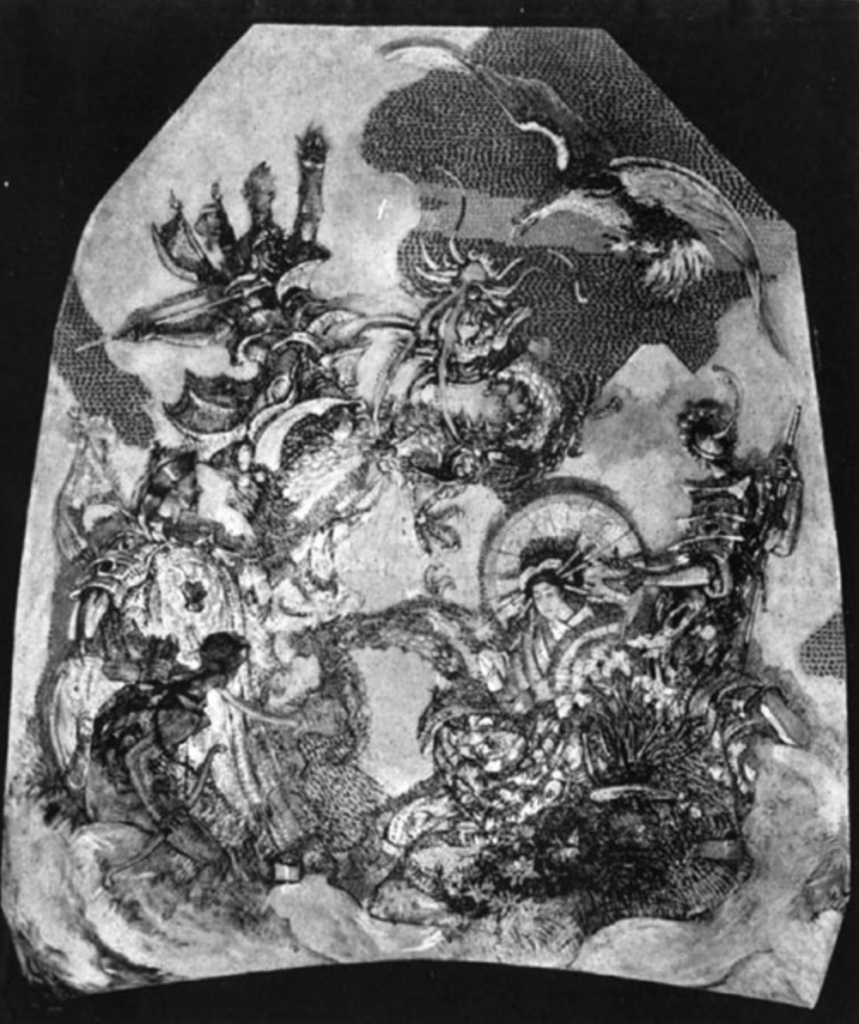
Title: Oriental Art –
Photo from The Sculpture and Mural Decorations of the Exposition – A. Stirling Calder. Website: Books About California
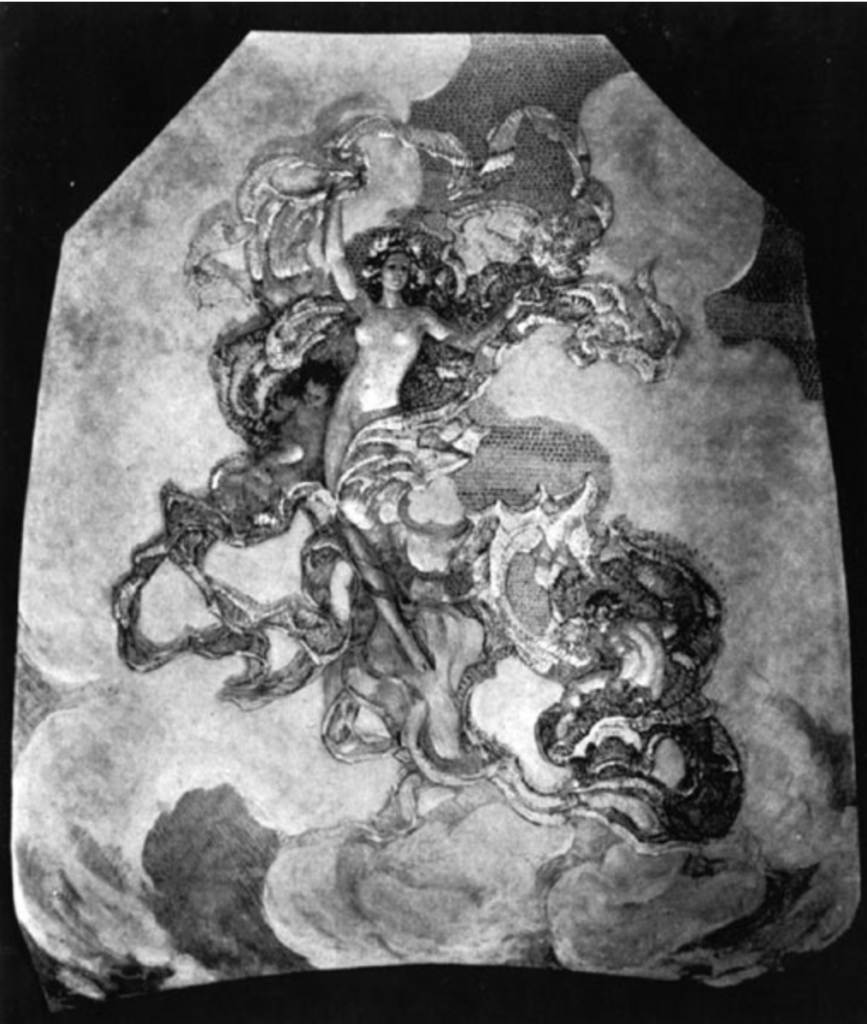
Titled: The Golden Wheat – Photo from The Sculpture and Mural Decorations of the Exposition – A. Stirling Calder. Website: Books About California
350 Bush
Financial District

The history of the Mining Exchange can be read here, as this is a follow up post regarding the “historic restoration” of the building that took place in 2018.
The City of San Francisco has a policy that allows developers to put up a history vignette in place of actual historical restoration. Walking into the building, in the left hand wing is a television screen with lovely photos of San Francisco and an attempt at an artful history review. It fails.
 *
*
The most important aspect of the restoration was the the terra-cotta facade, the missing pieces, the ornamentation above the arch, were recast by Gladding McBean, the original creator of the tympenum sculpture.
 The plaster walls of the old trading hall have been replicated, and the detailed ceiling has been restored.
The plaster walls of the old trading hall have been replicated, and the detailed ceiling has been restored. 

Historic photos of the ornamental plaster in the SF Miners Exchange

All this is publicly accessible — you can walk through the trading hall and the tower’s lobby and emerge on Pine Street but it is sadly not a welcoming space or a properly restored space.

The Miners Exchange prior to restoration
The central hall was originally designed to hold hundreds of traders, complete with a catwalk at the mezzanine-level trading floor and a chalkboard along one wall to keep track of stock fluctuations.
Now this marvelous open space sits empty except for four round columns along the edge.

Photos of the Miners Exchange in its heydey, photos from the SFPL.


Pre-construction photo showing the ceiling before restoration
Laguna Honda Hospital
375 Laguna Honda Boulevard
Foreshill
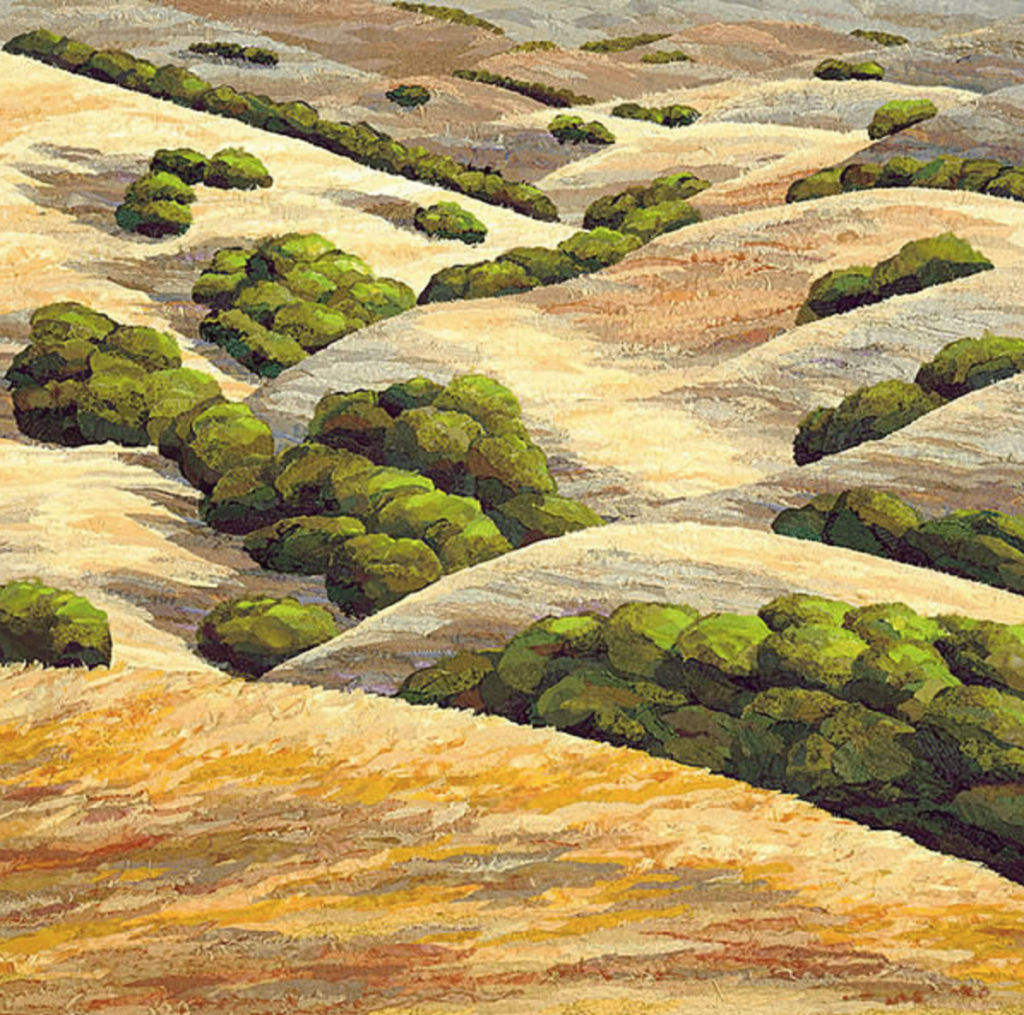
Bay Area Foothills by Merle Axelrad Serlin
These collages by Merle Axelrad Serlin are comprised of thousands of small pieces of fabric, fiber, paint and cloth. The fragments are carefully arranged, layered, pinned and sewn together onto a cotton canvas. The artist uses a variety of fabrics including, but not limited to, cotton, linen, rayon, wool, silk, hemp, and tulle. When she is not able to find a piece of fabric that achieves the desired effect, Serlin uses acrylic-based fabric paints to create her own.
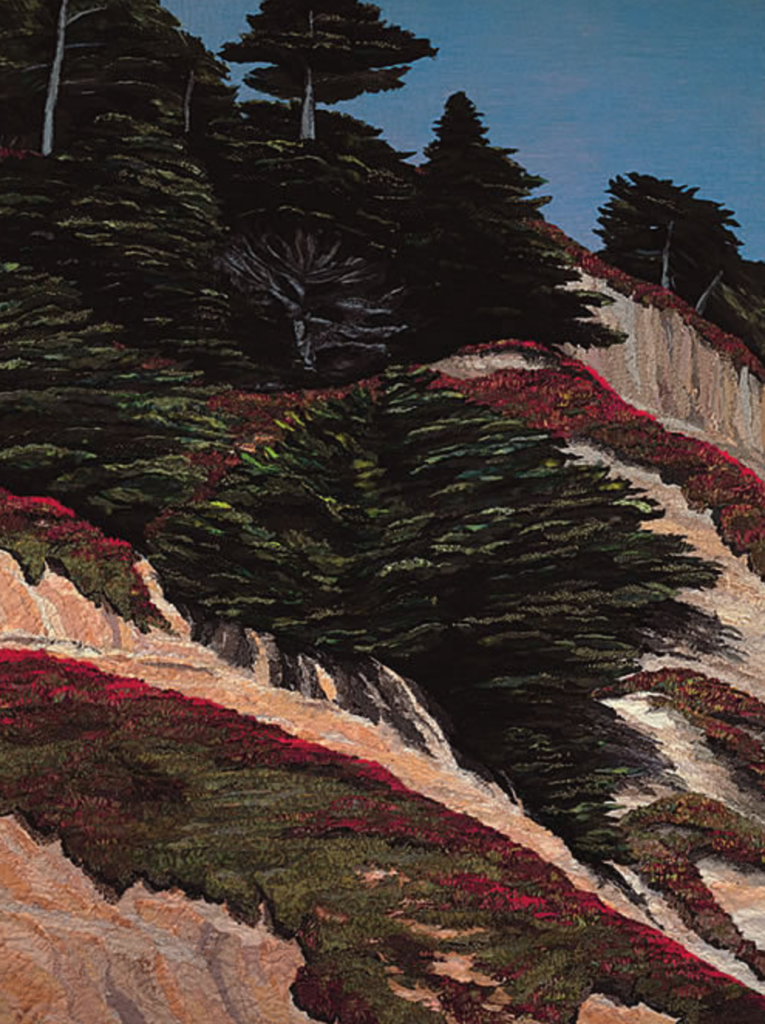
Cliff at Lands End
Merle Axelrad Serlin was a successful and pregnant architect when she made her first quilt, a predictably sewn coverlet of black, gray, pink and green that she finished the day before her son was born. “It was a dog . . . god-awful,” she recalls more than a decade later. But Serlin was clearly a quick study with no dearth of talent. She took a quilting class, won a few awards and switched to quilts as wall art.
With a little tinkering, Serlin developed a layering technique that let her bring more color, light and texture to her projects. She calls it “fabric collage,” and one of her most recent works is a stunning example. In “California Ricelands,” a Sacramento Valley farmscape commissioned by the California Rice Commission, Serlin uses hundreds of pieces of material—some hand-painted or -dyed, others fresh off the bolt from the local fabric store. A golden field is executed in velvety chenille; the flooded paddies are in soothing shades of blue and green.
“People describe this as painting with fabric,” she explains. “But I see it more as a blending of painting and sculpture because it is a three-dimensional medium.” Serlin’s pastime became full time in the late 1990s, when she landed a contract with the California Environmental Protection Agency to complete eight landscapes for the agency’s downtown headquarters, depicting the heights of Mount Shasta to the Monterey Bay Canyon. Other commissions—public, hospital and private—have streamed in ever since. Her studio, on the second floor of the Art Foundry & Gallery at 10th and R streets, opens for Second Saturday every month. – Sacramento Magazine May 2010.
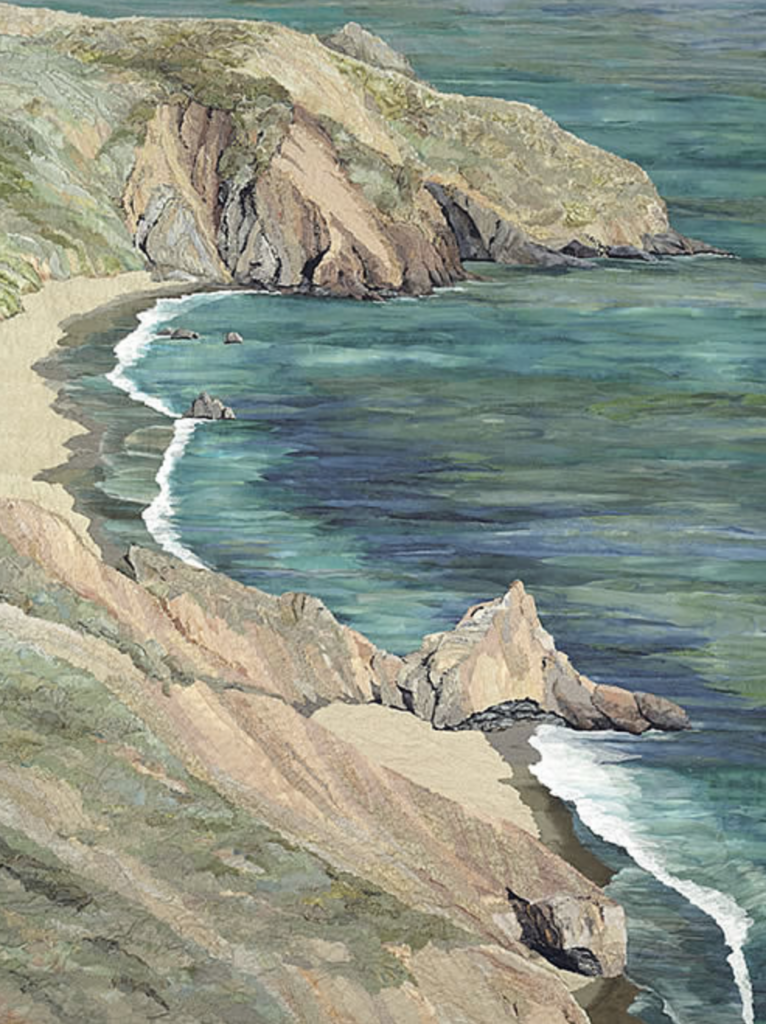
Marin Headlands
The art pieces are behind UV resistant glass and lit from above making photographing them nearly impossible, photos of the art pieces unframed are from the artist’s website.
The budget for the artwork in the new wing of Laguna Honda Hospital was $3million, thanks to the 1% for art program. The budget for these three pieces was $47,000.
Below are photos of the collages, as occurs in many public buildings the artwork takes second fiddle to the handout rack.
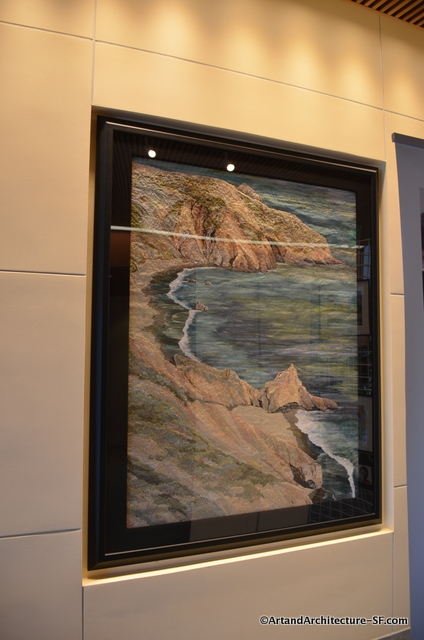 *
*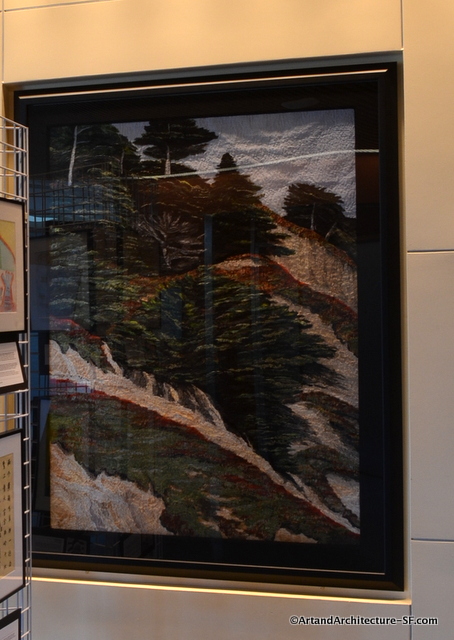 *
*
Laguna Honda Hospital
375 Laguna Honda Blvd.
Foresthill

These two pieces, which sit in rooms that are across the hall from each other, are titled Landscape and are made of terracotta.
Igarashi sculpted hundreds of clay pieces for these terracotta reliefs creating a textured landscape between the in-dining and living areas.

Japanese artist Igarashi has taught at Chiba University and the University of California, Los Angeles (UCLA). He collaborated in the foundation of the Faculty of Design at Tama Art University (Kaminoge Campus) to set up the first computerized design education in Japan and was the first Head of Design Department.
In 1994, he ended his 25 years of design activity and moved to Los Angeles to become a sculptor. After working with marble, he discovered terracotta and wood as his material. He returned to Japan in June 2004.
Igarashi has three pieces at Laguna Honda, one of which is in an accessible area off of the third-floor promenade.
The hospital had a $3 million budget for the artwork within the new wing of the hospital, thanks to the 1% for art requirement in San Francisco public buildings.
The budget for the three pieces provided by Takenobu Igarashi was $238,686
Much of the art at Laguna Honda is not accessible to the general public, so only 2 of Igarashi’s 3 pieces appear in this website.
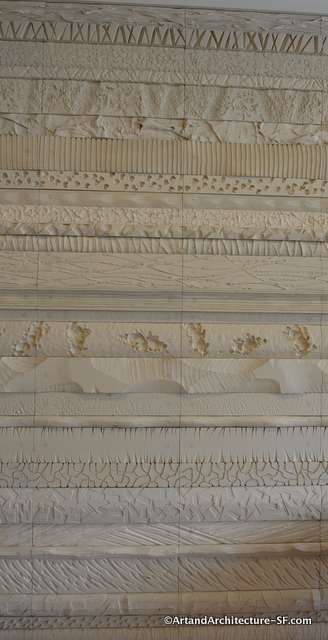
a close up of the layers of Takenobu Igarashi’s piece
Laguna Honda Hospital
375 Laguna Honda Boulevard
Foresthill

Bloom consists of a circular group of five granite lathe-turned elliptical forms with smooth honed finishes.
The artist knew that the sculptures would be viewed from above, evoking the concept of a star, a flower or possibly an asterisk.
For those that enter the patio area, the pieces encourage sitting as well as providing a tactile experience.
Jonathan Bonner received his BFA in 1971 from Philadelphia College of Art and an MFA in 1973 from Rhode Island School of Design.
Jonathan Bonner started his career as an artist in the late 1960s, when he wandered into the Philadelphia College of Art and was attracted to the noises and smells of the woodshop. He graduated from the school in 1971 and went on to study woodworking and metalsmithing at the Rhode Island School of Design. He soldered other artists’ jewelry for a living, but soon realized that he wasn’t interested in the assembly line. Bonner has tried his hand at many different things, from making musical instruments to running a business that specializes in handmade planing tools. But he is best known for his large sundials and weather vanes crafted from stone, metal or wood. (McCreight, “Jonathan Bonner, Whimsy and Vision,” Metalsmith, Spring 1984)
The hospital had a $3 million budget for the artwork within the new wing of the hospital, thanks to the 1% for art requirement in San Francisco public buildings.
The budget for Bloom was $55,000.
Much of the art at Laguna Honda is not accessible to the general public.
Laguna Honda Hospital
375 Laguna Honda Boulevard
Foresthill

Professions by Glen Wessels is one of five murals in the entry to the older wing of Laguna Honda Hospital. These five 8′ x 6′ murals were painted in 1934 with funding from the PWAP (Public Works Art Projects).
Glenn Anthony Wessels was born in Cape Town, South Africa on December 15, 1895, the son of a wealthy Dutch diamond merchant. The Wessels family moved to California about 1902, having lost everything in the Boer War. Wessels earned his B.F.A. at the California School of Arts and Crafts and his M.A. degree at UC Berkeley. He began his art career as an illustrator for the San Francisco Call. He furthered his art training at Academie Colarossi in Paris, and with Karl Hofer in Berlin and Hans Hofmann in Munich. While in Munich, he became Hofmann’s assistant and in 1930 returned to the U.S. as his interpreter and guide.
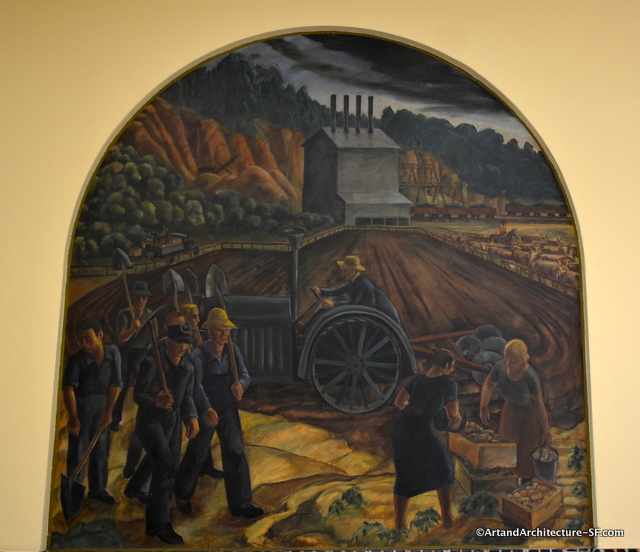
Earth by Glen Wessels
Wessels teaching career began at the California School of Arts and Crafts but he also taught at Mills College in Oakland, Washington State College, and the University of California Berkeley. He painted these five murals as part of the Federal Art Project and later became technical adviser and superviser in the Oakland area. In the early 1930s Wessels was the art critic for the San Francisco Fortnightly, and between 1934 and 1940, he was art editor for the San Francisco Argonaut. Wessels retired from teaching in 1963 and was invited by Governor Edmund (Pat) Brown to become a California State Commissioner of Fine Arts. He was a member of the San Francisco Art Association, Friends of Photography, the San Francisco Art Institute and the Oakland Art Museum.
Wessels final years were spent in Placerville, California where he died on July 23, 1982.
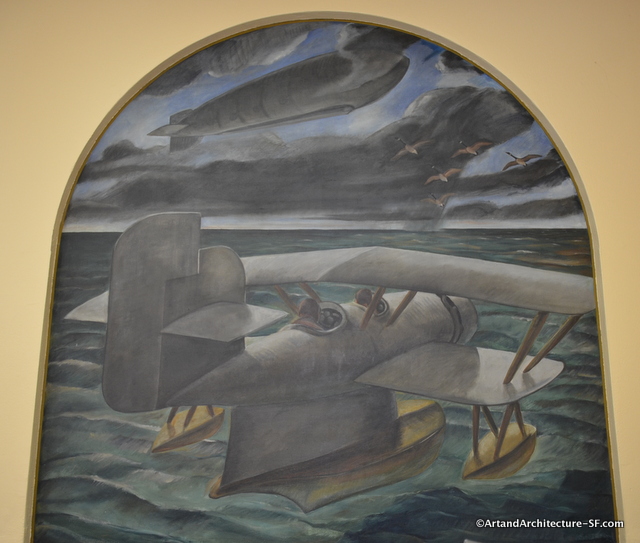
Air by Glen Wessels
These murals were lost for a time until they were “rediscovered” in 1981 when the hospital was being refurbished. Mayor Dianne Feinstein issued a proclamation in Wessels honor.
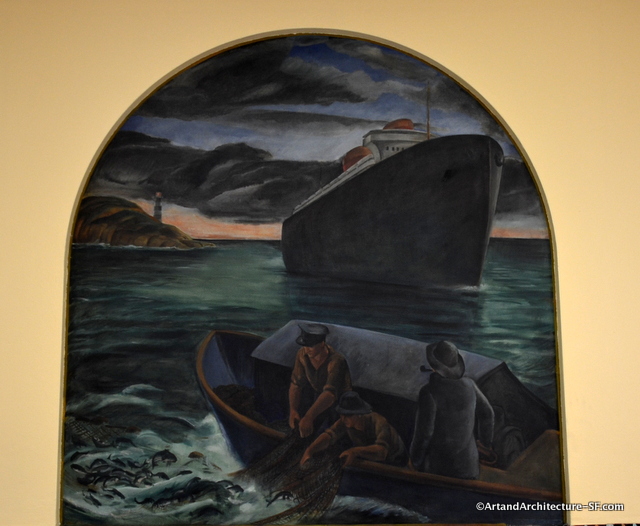
Water by Glen Wessels
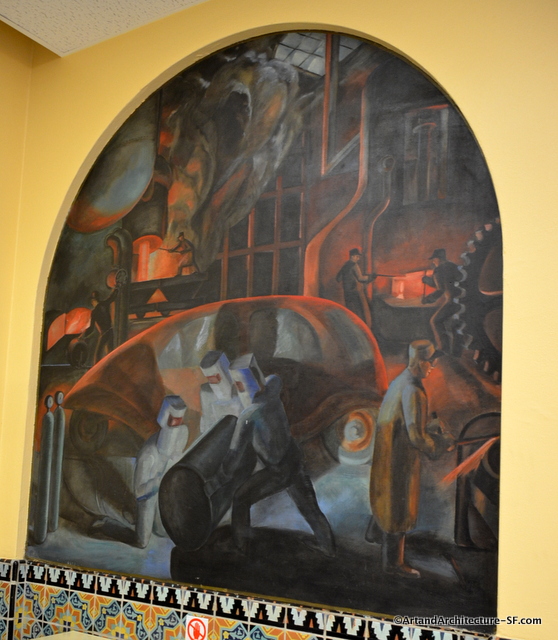
Fire by Glen Wessels
Pier 27
Point of View is comprised of two sculptures that resemble lighthouses — one is installed at the Port of San Francisco, and an identical tower is in Haifa, Israel.
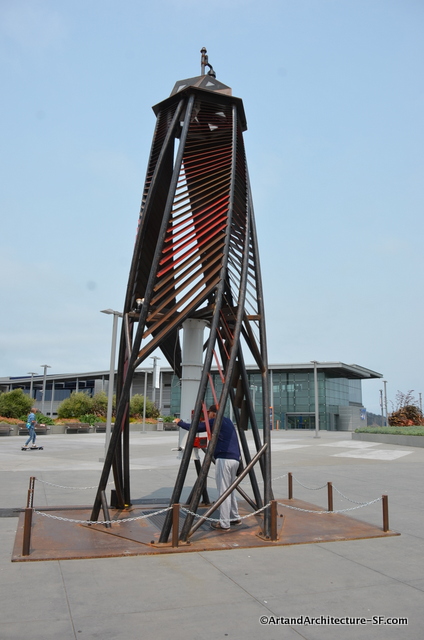 Viewers look into a periscope-like screen to see a live feed of the other location.
Viewers look into a periscope-like screen to see a live feed of the other location.
The installation is dedicated to San Francisco’s late Mayor Edwin Lee. The project aims to celebrate “the vibrancy of the cities’ art and technology sectors.” San Francisco and Haifa became sister-cities in 1972.
The Sister City Committee commissioned Saron Paz and Mathew Passmore to create the installation after San Francisco officials traveled to Haifa in 2016 with the mayor.
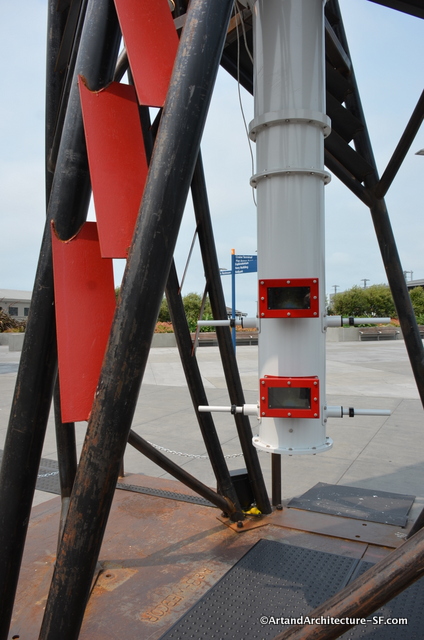 Saron Paz studied at the Holon Institute of Technology, The Design Academy Eindhoven, and The Sandberg Institute. He is CEO of the design studio ForReal Team.
Saron Paz studied at the Holon Institute of Technology, The Design Academy Eindhoven, and The Sandberg Institute. He is CEO of the design studio ForReal Team.
Mathew Passmore heads Morelab. Passmore is a conceptual artist, a professional musician, an attorney and the National Librarian for Cabinet magazine. He studied Analytic Philosophy at UCLA and Law at the University of California, Hastings College of Law.
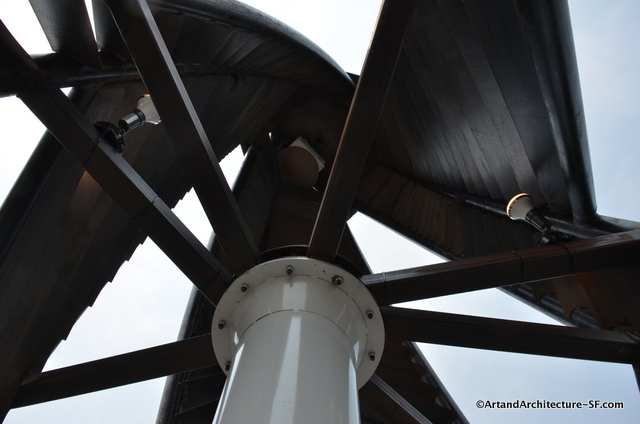
*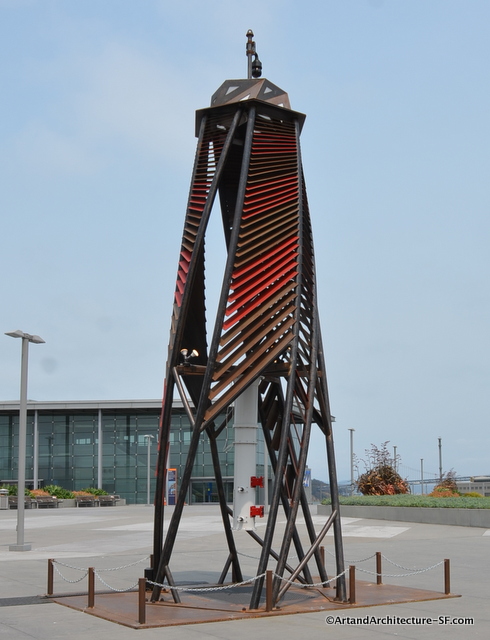
San Francisco Superior Court
850 Bryant Street

These two planters sit outside of the front entry of the San Francisco Superior Court, they are by Raymond Sells.
Raymond Sells was born in San Francisco in 1931. He studied at the University of California, Santa Barbara and San Francisco State University receiving a BA in 1959 and an MA in 1968.
He taught at Skyline College he died in 1983.

*
Transbay Terminal
Second and Folsom
 The largest piece of art in the Transbay Terminal is Jenny Holzer’s digital work “White Light,” which encircles the main atrium with 16-foot-high excerpts from historical and literary texts. All related to the Bay Area, they are spelled out in animated, pulsing LED configurations.
The largest piece of art in the Transbay Terminal is Jenny Holzer’s digital work “White Light,” which encircles the main atrium with 16-foot-high excerpts from historical and literary texts. All related to the Bay Area, they are spelled out in animated, pulsing LED configurations.
Some of these texts are on view for no more than 20 seconds; others run as long as 90 minutes. The longest excerpt thus far, taken from a work by poet Edith Arnstein Jenkins, had to be broken into shorter elements — its full length is five hours and 20 minutes.
 The artist told a press tour that the current content total of some 30 hours eventually will double or triple. Holzer said that her piece will give waiting travelers “something to keep them company and to occupy their minds.”
The artist told a press tour that the current content total of some 30 hours eventually will double or triple. Holzer said that her piece will give waiting travelers “something to keep them company and to occupy their minds.”
In the daytime, from below, letters are decipherable with some difficulty; from the second floor, one can watch through strips of LED lights, but they are unreadable close-up It is impossible to make out sentences across the way as they circle around. For this reason, I felt this piece was a complete fail. The works are not readable, but they do make for an interesting spinning group of letters to keep you occupied should you need to let your mind wander.
 Jenny Holzer (born July 29, 1950, Gallipolis, Ohio) is an American neo-conceptual artist, based in Hoosick Falls, New York. The main focus of her work is the delivery of words and ideas in public spaces.
Jenny Holzer (born July 29, 1950, Gallipolis, Ohio) is an American neo-conceptual artist, based in Hoosick Falls, New York. The main focus of her work is the delivery of words and ideas in public spaces.
Holzer’s studies included general art courses at Duke University in Durham, North Carolina (1968–1970), and then painting, printmaking and drawing at the University of Chicago before completing her BFA at Ohio University, Athens.
The Transbay Joint Power Authority (TJPA) committed $4.75 million to fund the acquisition of artwork for the program. The TJPA’s commitment is in the spirit of the city and county of San Francisco’s “Percent for Art Ordinance,” which allocates two percent of construction costs for the inclusion of public art in the civic structures and facilities, and is consistent with policies established by the Federal Transportation Authority encouraging the inclusion of art in transportation facilities.
TJPA engaged the San Francisco Arts Commission to manage and oversee the planning and development of the public art program.
The budget for White Lite was $1,340,000.

CCSF
Phelan Campus
Hall of Science
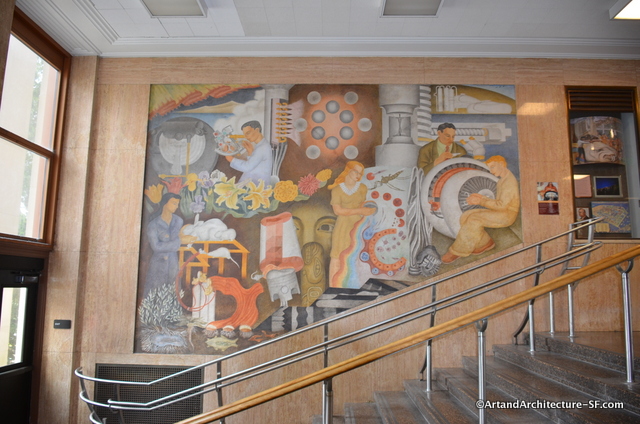
The Theory of Science is the title of two murals at the west entrance stairs of the Science Hall. The murals show students engaged in various branches of scientific research such as viewing bacteria through a microscope, conducting field research, and excavating dinosaur remains.
These were painted in 1941 as part of the New Deals’ Federal Art Project.
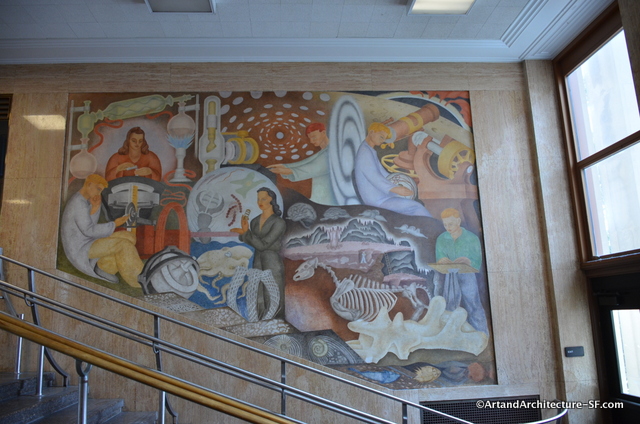
A restoration was completed in 2002 by CCSF faculty, staff, students, and an independent conservator, bringing these images close to their original state.
Frederick E. Olmsted Jr. was born in San Francisco in 1911. He died in Falmouth, Massachusetts in 1990.
Olmsted Jr. studied science at Stanford University and was a student of Ralph Stackpole’s at the California School of Fine Arts (CSFA) (now called the San Francisco Art Institute or SFAI).
Olmsted Jr. also worked in the WPA, assisting John Langley Howard and George Albert Harris in their Coit Tower murals in San Francisco, and creating his own mural on a three-foot panel called “Power” above the main entrance.
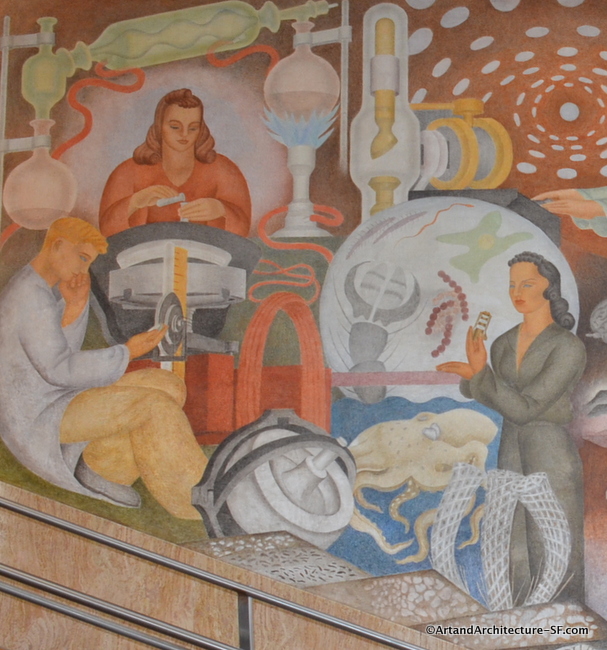
*
*
*
Olmsted is also responsible for two statues that sit outside of the Hall of Science that he carved during the 1940 Golden Gate International Exposition as part of the Arts in Action Exhibit.
CCSF Campus
Phelan Avenue
Diego Rivera Theater and Conlan Hall
During the second season (1940) of the Golden Gate International Exposition, organizers began the Art in Action program in the Hall of Fine and Decorative Arts. During the 1939 season, the hall had housed the art collections of European and Pacific cultures. The concept was a working art exhibit in which artists of many media, including sculptors, painters, muralists, weavers, stained glass artists, printmakers, potters, and engravers were invited to move their studios into the Hall and create their art while the public watched.
Artists included sculptor Ruth Cravath, mosaic artist Herman Volz, sculptor Frederick Law Olmsted, etchings artist Elizabeth Ginno Winkler, muralist Diego Rivera, and wood carver Dudley C. Carter.

A view of the Hall of Decorative and Fine Arts from the San Francisco Bay. The building served as the Palace of Fine and Decorative Arts during the GGIE and was constructed to serve as one of two hangar buildings built for the San Francisco airport that was planned for the island. (Library of Congress)
This is when Dudley Carter created The Ram. The sculpture, a bighorn mountain ram, was carved in just 30 days from a single redwood log using primitive instruments such as a wood axe.
At the conclusion of the fair, the college architect, Timothy Pfleuger, presented The Ram to Archibald J. Cloud, president emeritus of the college. It was to serve as the symbol of the college mascot.
Timothy Pfleuger was on the GGIE committee, it was his idea for the Art in Action project, and due to his also being the college architect, much of the finished art from Art in Action was always slated to end up at what was then San Francisco Junior College and after the war became City College of San Francisco (CCSF).
For five years The Ram was stored in the men’s gymnasium because of the absence of a place considered appropriate for it. With the acquisition of the west campus The Ram was placed outside, periodically changing locations, and from time to time students would paint it in the campus colors of red and white. Sometimes rival schools would repaint The Ram in their own school colors. In spring of 1983, The Ram was restored by Carter (who was by then 90 years old) with the use of a pickaxe and its original, natural redwood.
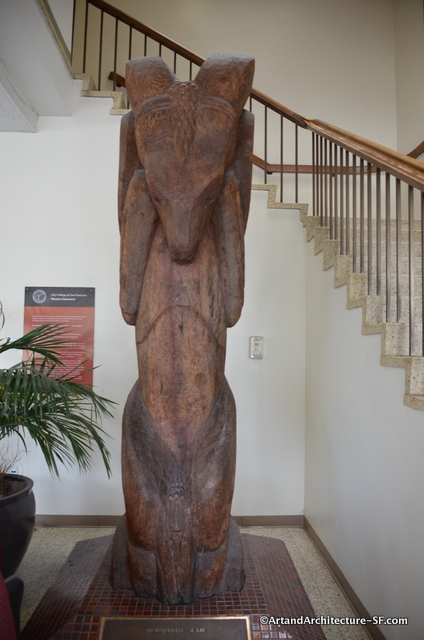
The Ram by Dudley C. Carver was originally carved at the GGIE and now stands in Conlan Hall at CCSF
The Goddess of the Forest is another redwood sculpture created by Carter during the GGIE. It was originally 26 feet tall, and had a girth at the base of 21 feet, for many years this piece was located in Golden Gate Park. The sculpture suffered extensive water damage to the lower half before being restored by CCSF Art Department instructor Roger Baird in 1992. It is now only 15 feet tall and stands facing the Diego Rivera mural in the Diego Rivera Theater.
It almost did not make it to CCSF. Difficulties arose in regards to paying for the statue’s move from Golden Gate Park when, then CCSF President Carlos B.Ramirez, decided that the estimated $8,000 moving fee was too high.
The actual moving fee was $3,000 and eventually paid for out of the Student Union’s budget.
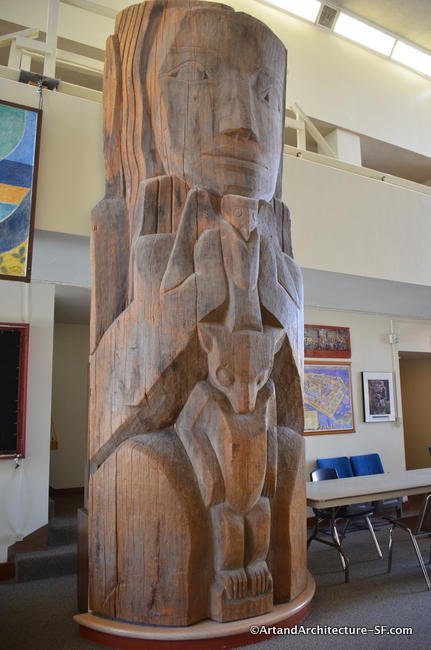
Goddess of the Forest originally carved by Dudley C. Carter at the GGIE now stands in the Diego Rivera Theater of CCSF
Diego Rivera worked directly across from Carter at the Golden Gate International Exposition and they became friends. Rivera said the following about Carter, “Here in the Fine Arts Building there is a man carving wood. This man was an engineer, an educated and sophisticated man. He lived with the Indians and then he became an artist, and his art for [a while] was like Indian art—only not the same, but a great deal of Indian feeling had passed into him and it came out in his art. Now, what he carves is not Indian anymore, but his own expression—and his own expression now has in it what he has felt and that is right, that is the way art should be. First, the assimilation and then the expression, only why do the artists of this continent think that they should always assimilate the art of Europe. They should go to the other Americans for their enrichment because if they copy Europe it will always be something they cannot feel because after all, they are not Europeans.”
Carter shows up in Rivera’s mural that, while originally painted at the GGIE, was always slated for CCSF.
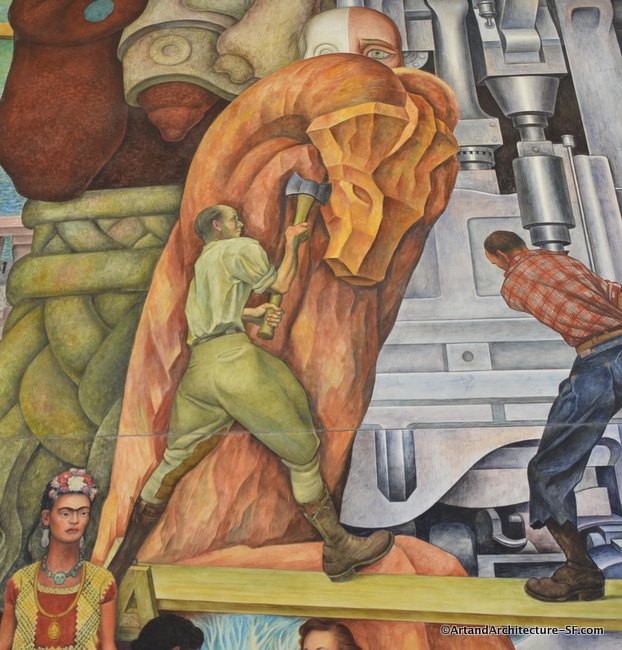
Dudley Carter depicted in Diego Rivera’s mural carving The Ram
The third sculpture by Carter is also in Conlan Hall in the first-floor hallway. This is titled The Beast.
The Beast was actually sculpted by Dudley Carter at Porter College at the University of California in Santa Cruz in 1983. The piece was given to City College by Carter on the urging of the then college president, Carlos Ramirez.
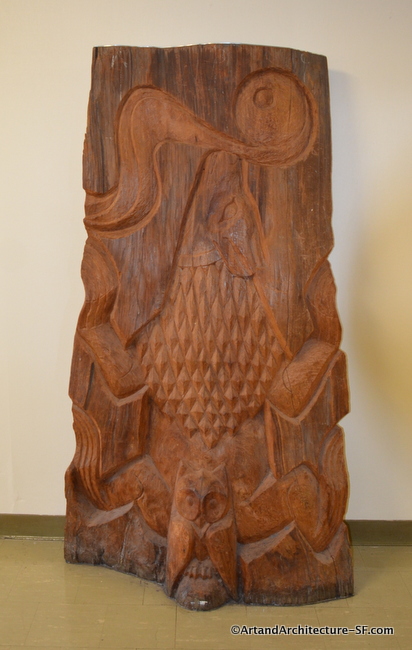
Beast by Dudley C. Carter
Born in New Westminister, Canada on May 6, 1898, Dudley Carter was the son of a woodsman. He was six years old when he began helping out in his father’s lumber camp.
Raised among the totem-carving Kwaquit and Tlingit tribes, he took part in their ceremonies. About 1929, he moved to Seattle where he had art lessons at the Cornish School and studied sculpture at the Art Institute.
Moving to California in the mid-1930s, he lived in San Francisco and worked for the Federal Art Project. He later lived in Carmel where he built houses out of trees that he felled himself. He died in 1992 in Bellevue, Washington.
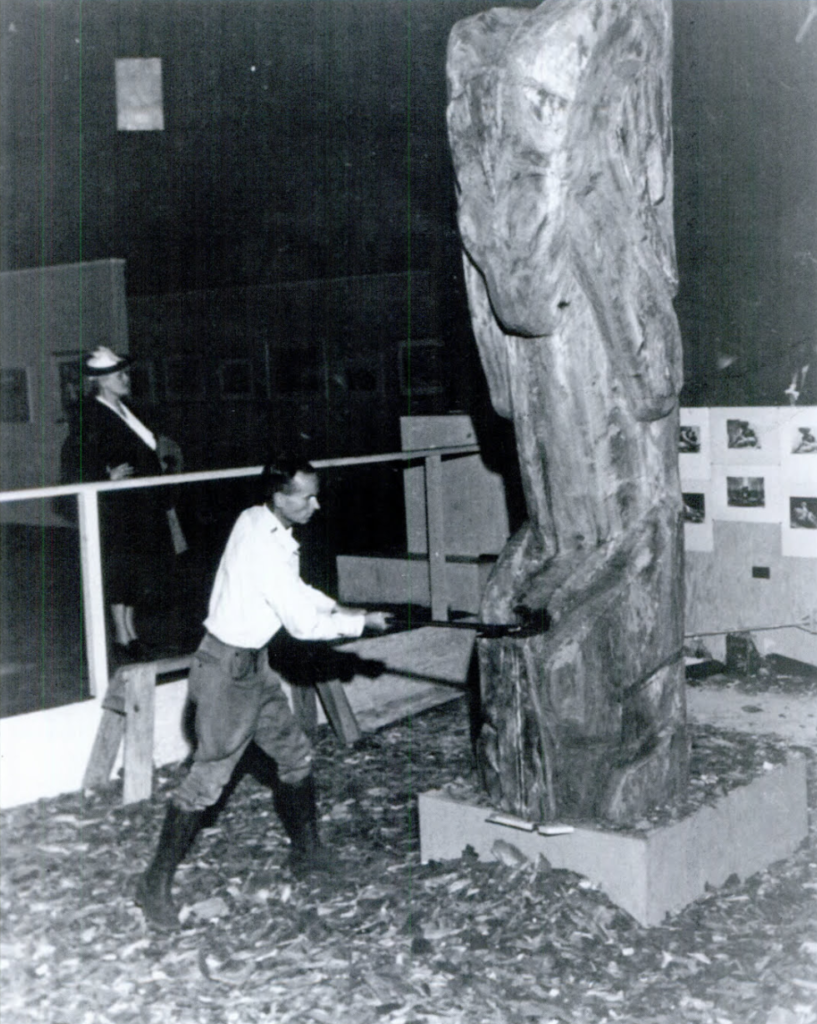
Carter working on The Ram during the GGIE surrounded by wood chips (Bancroft Library)
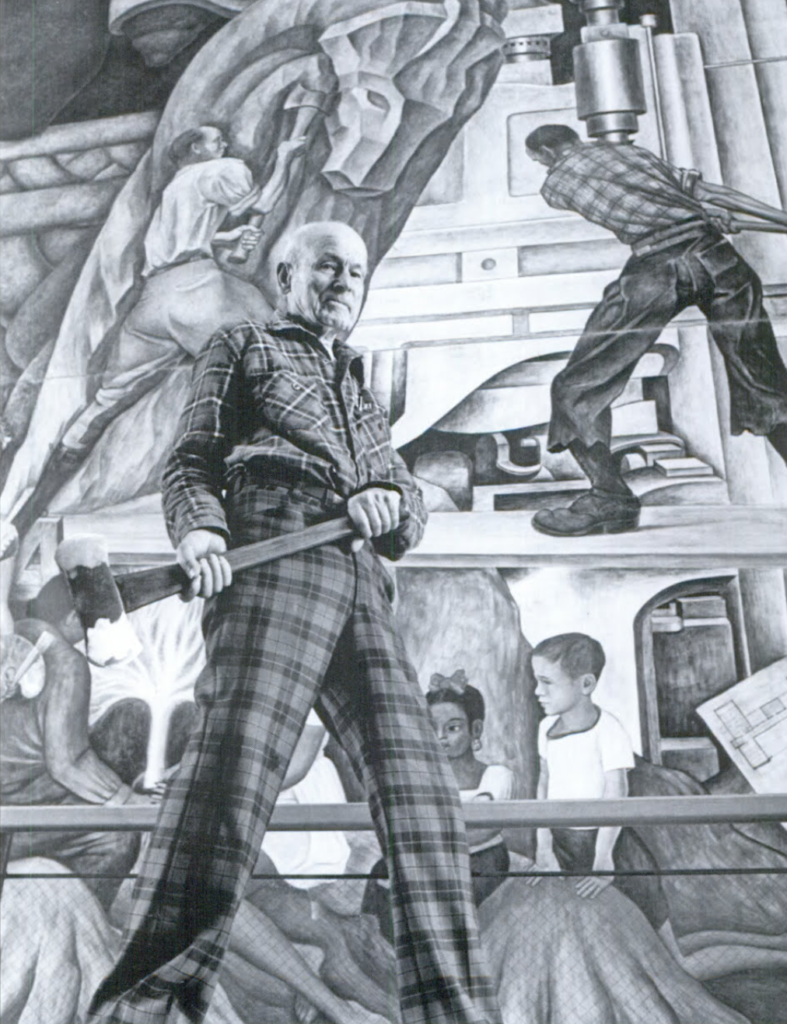
Carter standing with one of his axes in front of his likeness in the Diego Rivera Mural (Bancroft Library)

Goddess of the Forest in Golden Gate Park 1951 (SFPL) – Notice the lower portion of the goddess’s legs are still intact. The sculpture now ends just below the feet of the small animal at her knees.
North Shore Pump Station
The intersection of Bay Street and Embarcadero
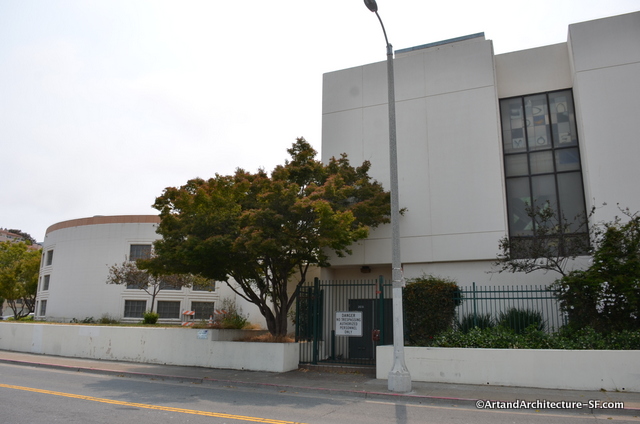
The stained glass window in the North Shore Pump Station was created by Narcissus Quagliata.
The piece was commissioned in 1980-81. According to the Arts Commission meeting minutes of July 12, 1982, the total cost for the commission of a 12-panel window was $6665.
Narcissus Quagliata has been on this site before.
He was born in Rome, Italy in 1942 where he studied painting with Giorgio De Chirico. Narcissus moved to the United States in 1962 and studied at the San Francisco Art Institute receiving both a Bachelors and a Masters degree.
Quagliata’s main residence is in Mexico, but he also works in the United States and Europe.
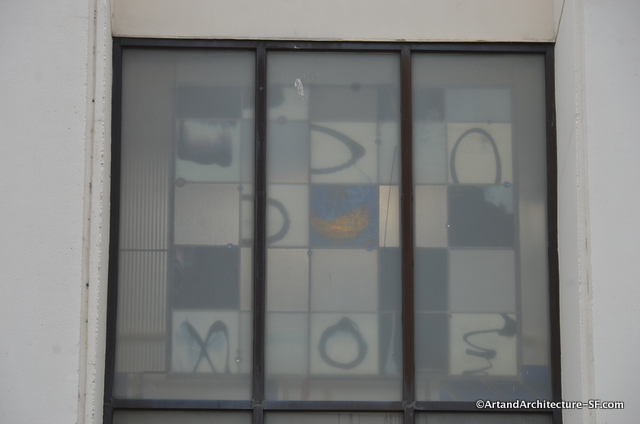
The glass is difficult to see from the outside of the building, and the building does not have public access.
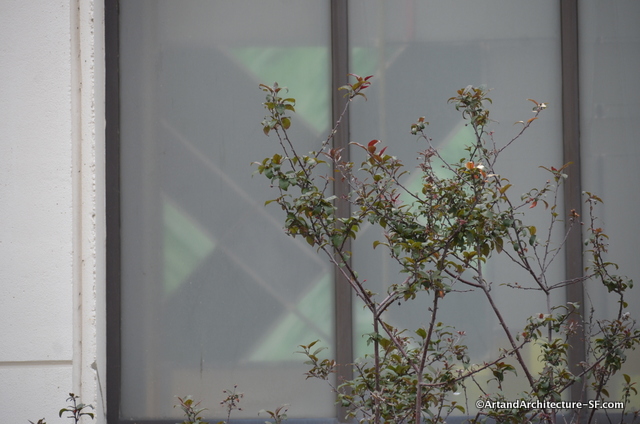
San Francisco Public Library
Grove Street Entrance
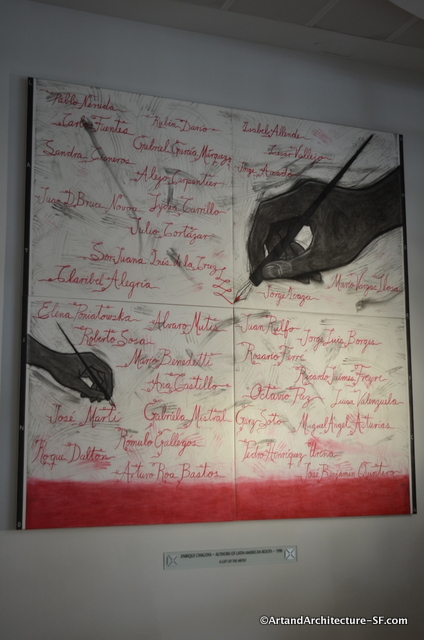
This art work of charchoal and pastel on paper and canvas is by Enrique Chagoya. It was a gift from the Mexican consulate in San Francisco.
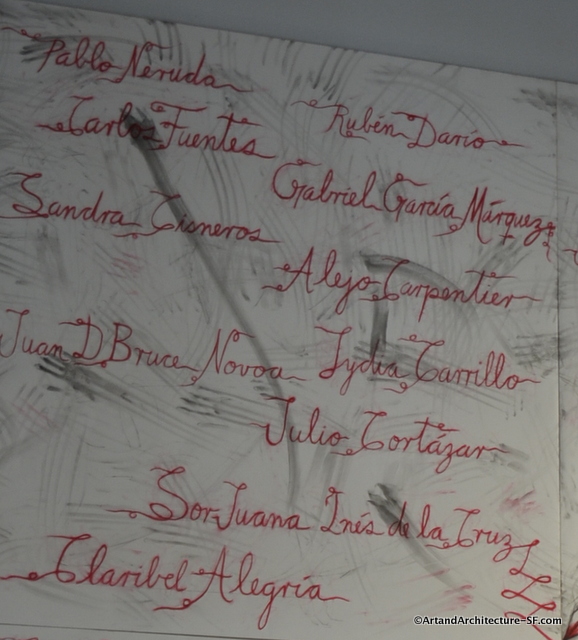
Measuring 160 inches square, the mural contains some thirty names of prominent Latino American writers and poets who have made important contributions to literature. They include Claribel Alegria, Isabel Allende, Jorge Amado, Manlio Argueta, Miguel Angel Asturias, Mario Benedetti, Jorge Luis Borges, Lydia Cabrera, Alejo Carpentier, Rosario Castellanos, Ana Castillo, Sandra Cisneros, Julio Cortazar, Ruben Dario, Rosario Ferre, Carlos Fuentes, Romulo Gallegos, Jorge Icaza, Sor Juana Inex de la Cruz, Jose Lezama Lima, Jose Marti, Gabriela Mistral, Pablo Neruda, Octavio Paz, Elena Poniatowska, Roberto Sosa, Luisa Valenzuela, Cesar Vallejo, and Mario Vargas Llosa.
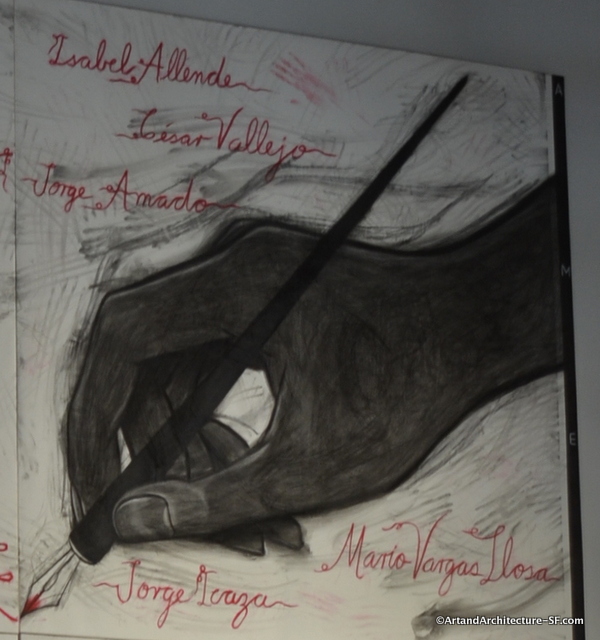
Enrique Chagoya (born in 1953) is a Mexican-born painter and print-maker. His subject is the changing nature of culture.
Chagoya was born in Mexico City in 1953. He was partly raised by an Amerindian nurse who taught him to respect the indigenous people of his country and their history. He studied economics at the National Autonomous University of Mexico in Mexico City in 1975.
In 1977, Chagoya immigrated to the United States, where he worked as a free-lance illustrator and graphic designer and for a time, in 1977, with farm laborers in Texas. In 1984, he earned a BFA at the San Francisco Art Institute and in 1987 an MFA at the University of California at Berkeley. He lives in San Francisco.
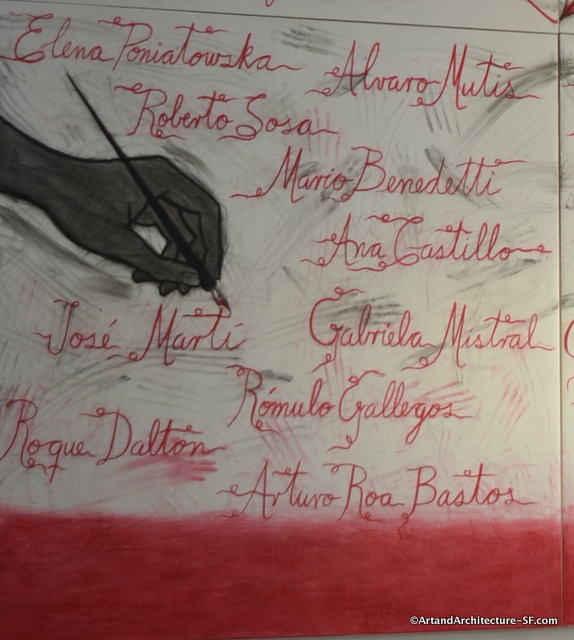 *
*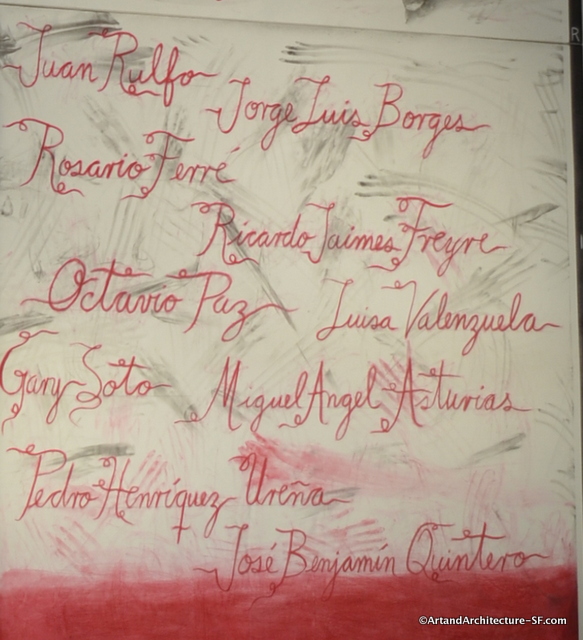
Childcare and Development Center
CCSF Phelan Campus
The building is now Closed
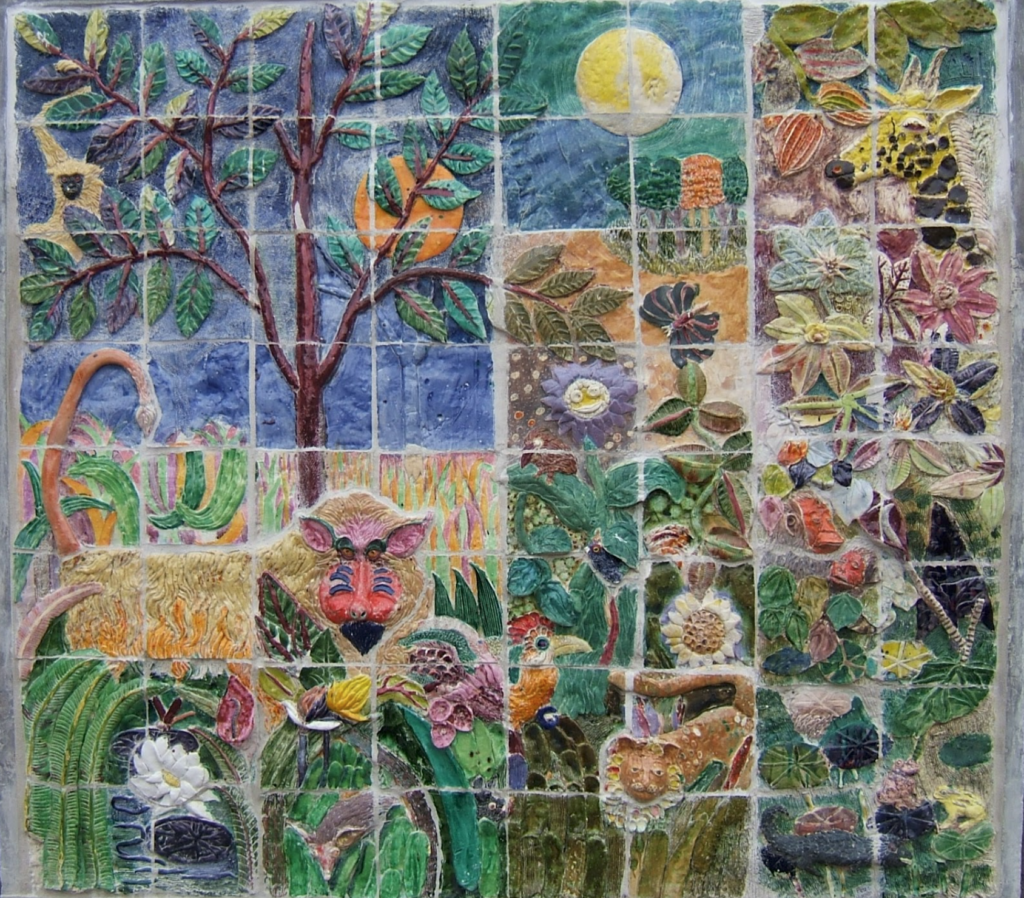
This whimsical mural is by ceramic artist Peter VandenBerge. It measures 8′ by 5′ and is made of ceramic tiles.
Vandenberge has been on this site before.
VandenBerge was part of the legendary group at University of California, Davis, during the 1960s. Working under Robert Arneson he was part of the Funk Art movement but evolved in his own direction. He is best known for his larger-than-life busts and figures, elongated beings that are roughly constructed, reminiscent of ancient tribal art, and finished with texturing, glazes, and stains. VandenBerge has said that the figures arise out of long ago memories of puppet shows he loved as a child in Indonesia, the memories blurred and mixed with the variety of experiences that have comprised his life since those days. In addition to his work as a studio artist, VandenBerge has had a long and successful career as a teacher: first at California State University, San Francisco and then for nearly 30 years at his alma mater, California State University, Sacramento where he is presently Professor Emeritus having fully retired in 2003.

This piece was originally commissioned by the SFAC, who was unable to locate an appropriate location for it. It was offered to CCSF and was displayed at the south end of the library reading room in Cloud Hall. Following construction of the Rosenberg Library, the mural was placed in storage and then installed at the Orfalea Center in 2008. The center has since closed permanently.
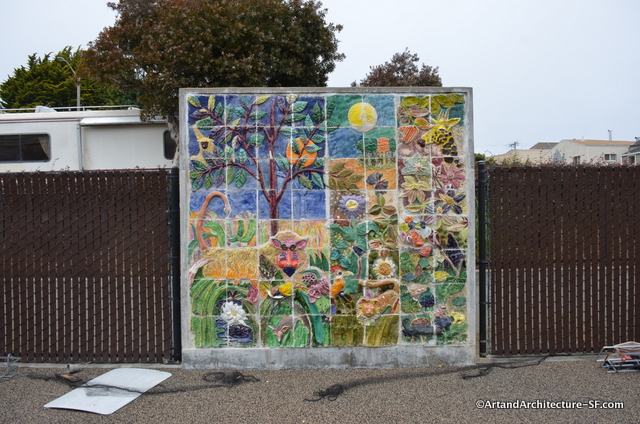 The mural is still there, and hopefully, it will be moved to a new location when the area is rehabbed.
The mural is still there, and hopefully, it will be moved to a new location when the area is rehabbed.
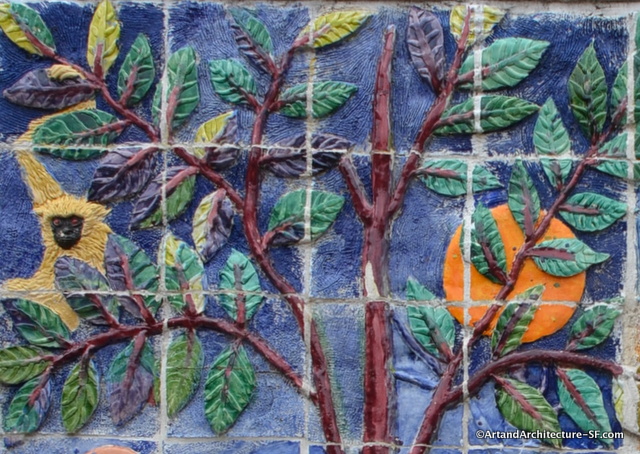 *
*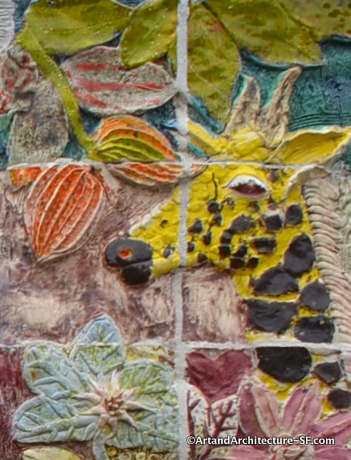 *
*
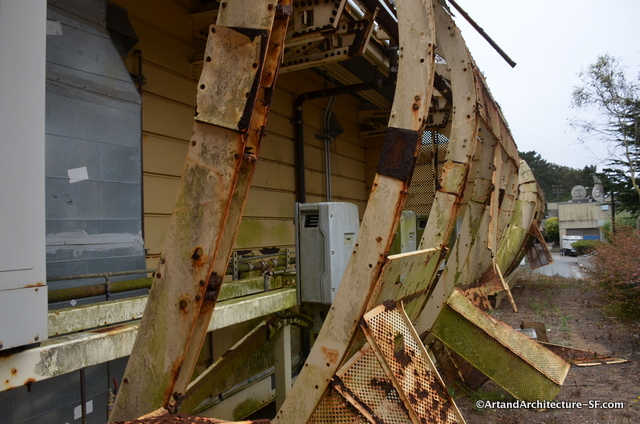
A small indication of the state of the buildings that made up the Orfalea Center, and why it is no longer in use, but whose architecture is fascinating.
Originally created for the Golden Gate International Exhibition
Moved to Steinhart Aquarium
Moved to CCSF
In Storage
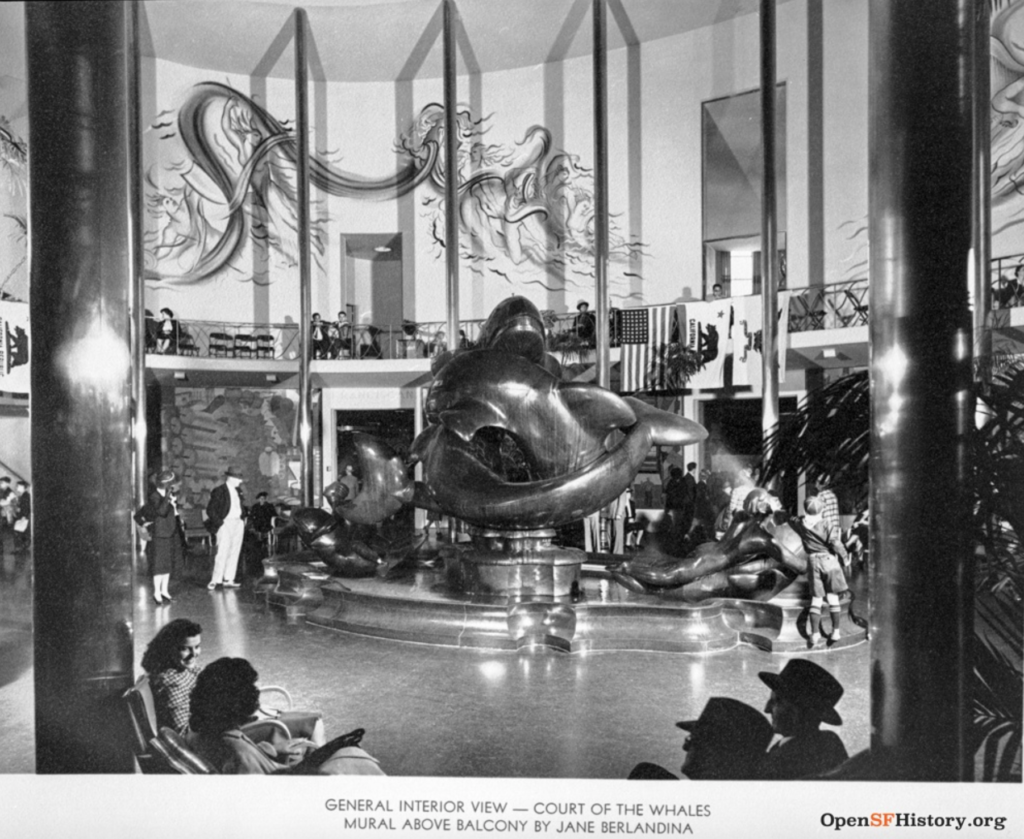
Photo from: OpenSFHistory / wnp37.03052.jpg
These whales were in the San Francisco Building at the Golden Gate International Exhibition and were sculpted by Robert Howards.
After the GGIE closed the whales were moved to a prominent place in front of the Steinhart Aquarium in Golden Gate Park
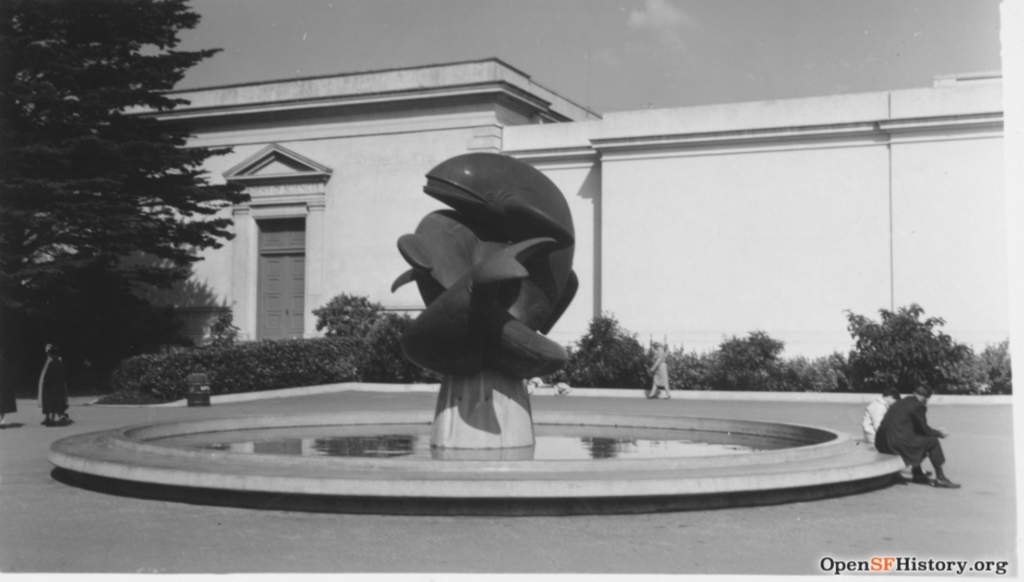
Photo from: OpenSFHistory / wnp27.5859.jpg
Robert Boardman Howard (1896–1983), was a prominent American artist active in Northern California in the first half of the twentieth century. He was celebrated for his graphic art, watercolors, oils, and murals as well as his Art Deco bas-reliefs and his “Modernist” sculptures and mobiles.
Howard was born in New York City on September 20, 1896, to architect John Galen Howard and society belle Mary Bradbury. When he was six years old, the family moved to Northern California. They settled in Berkeley where John G Howard was hired to supervise the erection of the Hearst Memorial Mining Building at the University of California. Robert completed grammar school, but dropped out of Berkeley High School and was tutored privately.
Between 1913 and 1916 he studied at Berkeley’s California School of Arts and Crafts (today’s California College of the Arts). He became acquainted with Alexander Calder in 1915. After graduation, he traveled across the country on a motorcycle to New York City to continue his training at the Art Students League under Kenneth Hayes Miller and F. Luis Mora. He returned to California in 1918, joined the U.S. Army Signal Corps, and was sent to France. At the end of World War I, he studied in Koblenz and in Paris at the Academie Colarossi and the Academie de la Grand Chaumiere.
Notable work by Howard includes: a bas-relief of a phoenix at Coit Tower, the reliefs at the Paramount Theatre (1931–32; specifically the reliefs on the auditorium walls, stage and ceiling), the 1935 cast-iron bas-relief for the Badger Pass Ski House in Yosemite National Park, four massive murals and assorted sculptures for other G.G.I.E. pavilions, including the Brazil Building, California Building, Western State Building, and Ghirardelli Building, two bas-reliefs in cast stone titled Power and Light, at the Pacific Gas and Electric Mission Substation in San Francisco, the City Club of San Francisco’s grand staircase balusters, the linen-based mural in the Mural Room at the Ahwahnee Hotel in Yosemite National Park, the massive bas-reliefs of dancing and musical figures on the exterior of the Berkeley High School Community Theatre, and the 1958 sculpture Hydro-Gyro at the San Jose IBM Research Center.
This sculpture is owned by the San Francisco Arts Commission but is stored on the CCSF campus waiting for restoration and installation. The CCSF administration, the CCSF Works of Art Committee, and other faculty and staff are working with the Arts Commission to arrange funding.
Laguna Honda Hospital
375 Laguna Honda Blvd
Forest Hill

These stained glass windows reside in the chapel of the 1920’s Spanish Revival portion of Laguna Honda Hospital.
The groundbreaking ceremony of the hospital was overseen by Mayor James “Sunny Jim” Rolph, the hospital opened in 1926, having replaced an earlier almshouse”.
The artist is unknown at this time, although the author is working hard to find out who executed these lovely pieces.
 *
*
 *
*

The entry to the old wing of Laguna Honda Hospital where the chapel resides.
Fragrance Garden
Botanical Garden
Golden Gate Park
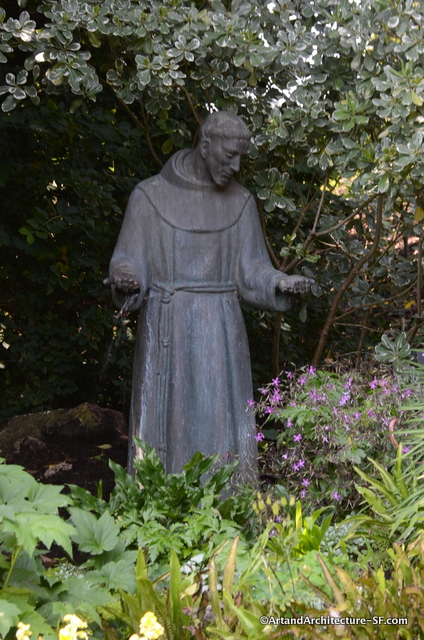
This statue was part of the 1939 Golden Gate International Exhibition on Treasure Island. It is by Clara Huntington who has been on this site before. Huntington was the adopted daughter of Collis Potter Huntington, one of the Big Five railroad magnates.
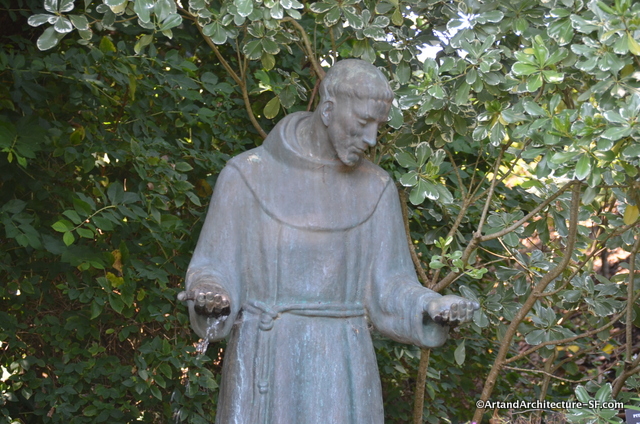
“Oh, Clara Huntington, yes, Clara Huntington Young. She is an older woman, much older than I, and she did the St. Francis figure, you remember, that was among the daisies. I think she’d worked some in the East. But I think it was when I first moved up here that she called me and offered me a model’s stand, a great big one, which I had to reject because I couldn’t put it in my little studio. But she was quite a bit older than I and she wasn’t working at the time. But she did that very nice bronze St. Francis. I think it had different flowers around it at different seasons in the Fair, but I remember it with a lot of daisies around it. She may not have done it just for the Fair, but it was a charming addition to the Fair, I thought. But she was a very good sculptor. She belonged to the old school.”
From an interview of Ruth Cravath Conducted by Ruth Teiser and Catherine Harroun
TWO SAN FRANCISCO ARTISTS AND THEIR CONTEMPORARIES, 1920-1975
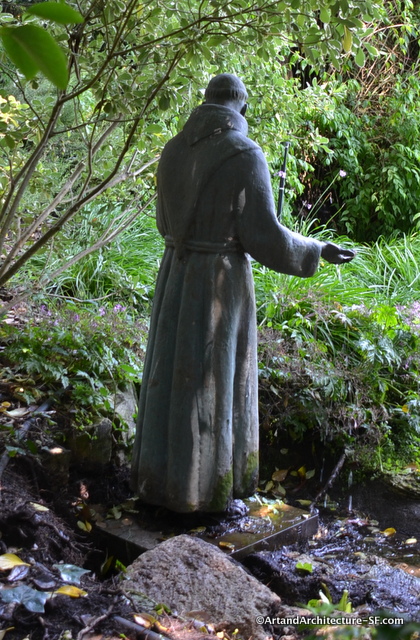
Mission Police Station
630 Valencia Street

Seven Dancing Stones and Seven Dancing Stars is the creation of artist Gary Dwyer.
Installed in 1984, Seven Dancing Stones and Seven Dancing Stars sits in the lobby of the police department. Dwyer created this sculptural installation based on a legend of the Ohlone Indian tribes which originally inhabited the area. The legend refers to the cluster of stars called the Pleiades. Stone furniture in the lobby is arranged in the pattern of the Pleiades. Framed panels feature imaginary legends about the Pleiades as told by the area’s diverse residents.
 Gary Dwyer taught Landscape Architecture at Cal Poly and was fascinated by the links between sculpture and designing landscapes. Dwyer is also a photographer, whose work has been published in numerous magazines.
Gary Dwyer taught Landscape Architecture at Cal Poly and was fascinated by the links between sculpture and designing landscapes. Dwyer is also a photographer, whose work has been published in numerous magazines.
The work was commisioned by the SFAC with a budget for the project of $30,000.
San Francisco Public Library
3rd, 4th, and 5th Floors
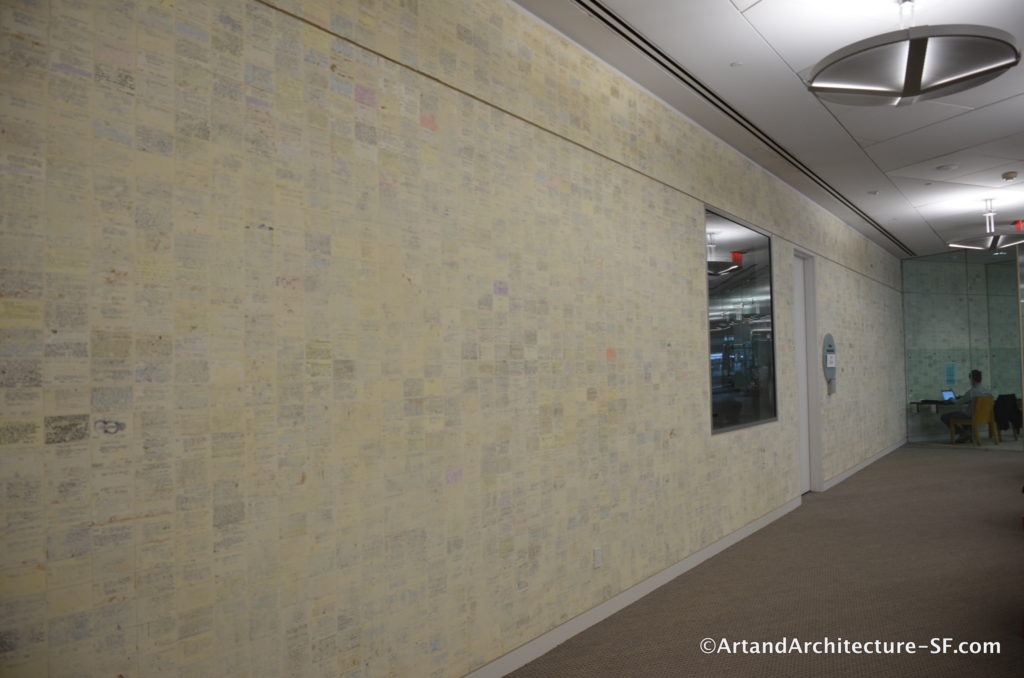
With the move to the new Main Library, items in the card catalog (used to access the collection for more than 100 years) have been replaced by an online computer system.
Artists Ann Hamilton and Ann Chamberlain embedded these obsolete cards in plaster covering the principal diagonal wall on three levels of the building.
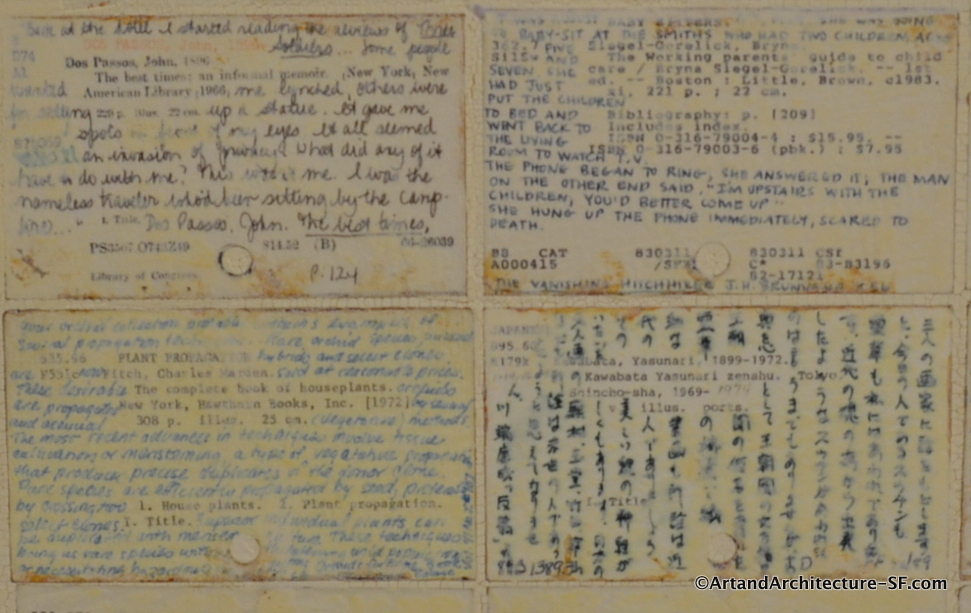 Each card is annotated with a quote from its corresponding book or from another book associated with the title by subject matter.
Each card is annotated with a quote from its corresponding book or from another book associated with the title by subject matter.
Nearly 200 individuals annotated the cards in a dozen different languages. The cards not only represent a process of research unique to the person who created them but also expresses the diverse meanings derived from reading.
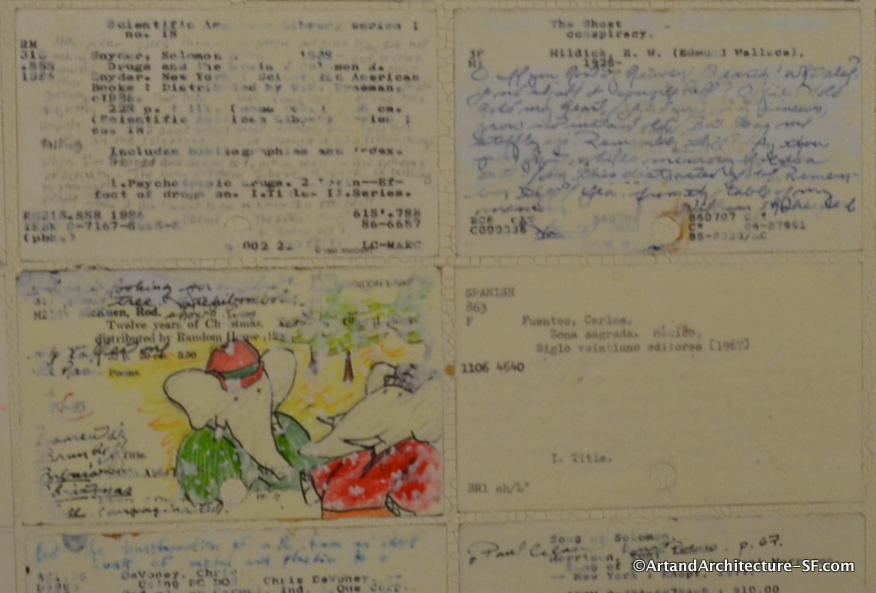 Moreover, the annotations on the cards expose the interior of books-the text at the heart of a library’s holdings. The wall represents a window into a world of books that can be browsed by those who enjoy the library and its collection.
Moreover, the annotations on the cards expose the interior of books-the text at the heart of a library’s holdings. The wall represents a window into a world of books that can be browsed by those who enjoy the library and its collection.
The project was part of the 2% for Arts program and cost $108,000.
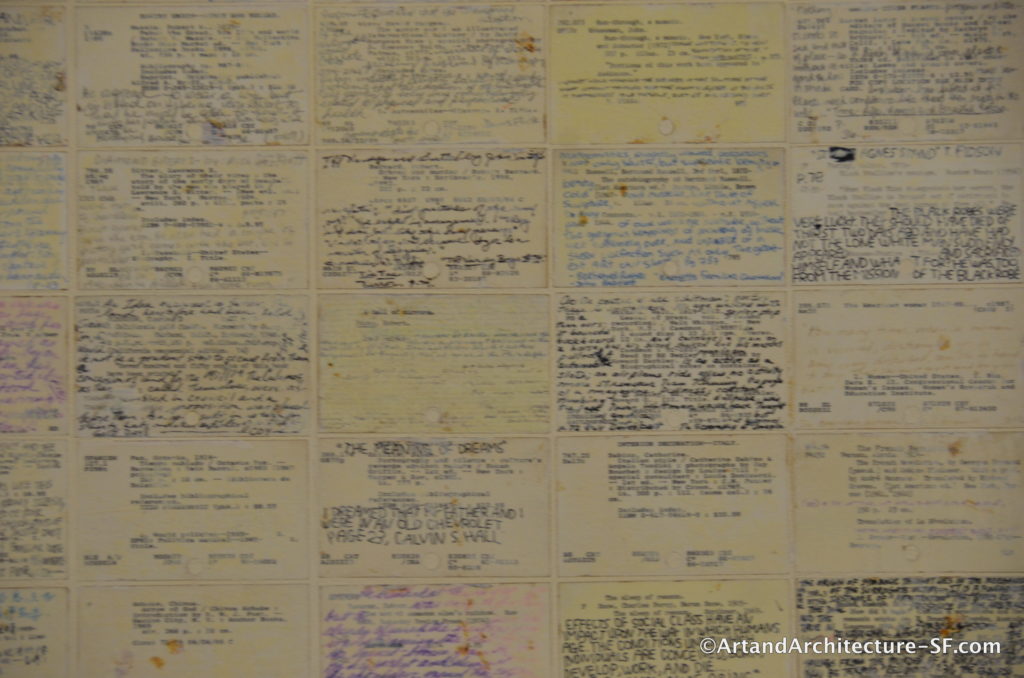
San Francisco Public Library
Atrium area

Constellation by Artist: Nayland Blake – Lighting by Architectural Lighting Design
160 names of writers are illuminated on a wall that rises five stories behind the grand staircase in the atrium of the San Francisco Public Library.
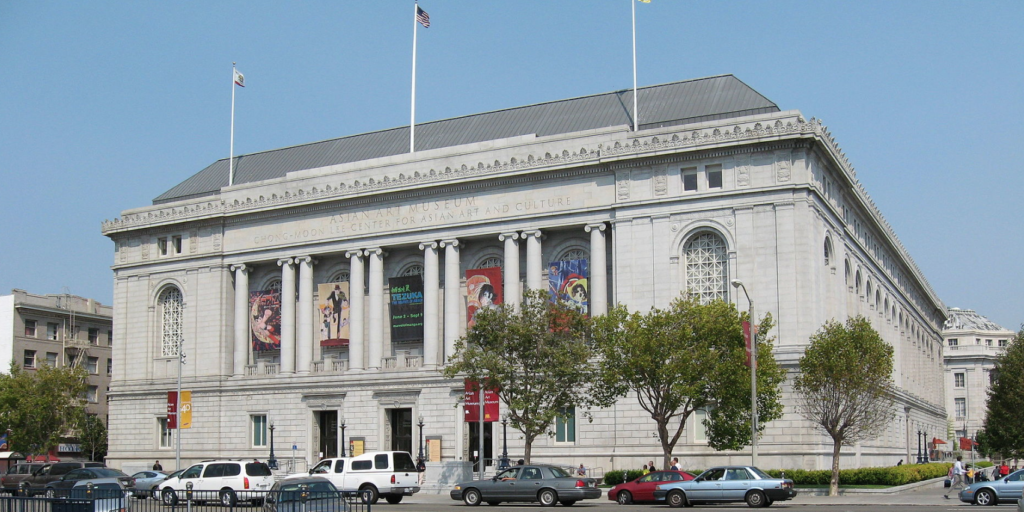
The old San Francisco Public Library now houses the Asian Art Museum
The artist’s work is inspired by a Beaux Arts tradition with origins in the Bibliotheque Saint-Genevieve in Paris (a model for the old Main Library). On that building, authors’ names were inscribed on the facade according to the location of their works inside.
Nayland Blake revisits this idea of an index of authors with glass shades placed before fiber optic light beams. Each shade is inscribed with the name of an author whose work is part of the library collection. The wall is designed to hold 200 more names as patrons endow additional shades and lights.
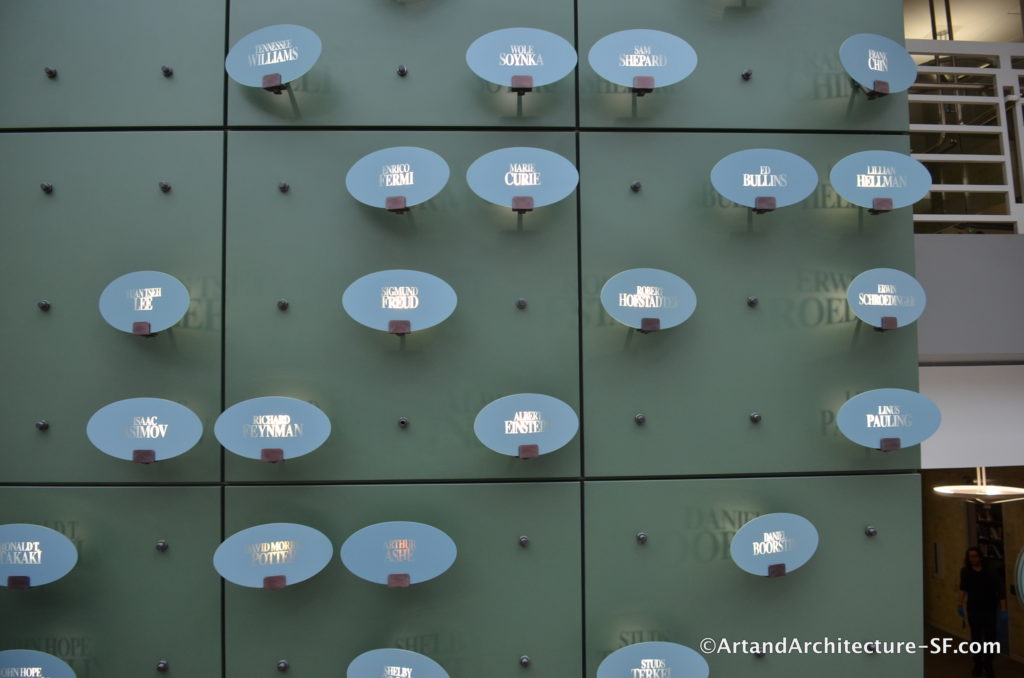 To select the first 160 names, the artist formed a guidance committee of local scholars and community members to develop a list of recommendations. Blake then held a series of public meetings in the branch libraries to solicit community response, as well as suggestions.
To select the first 160 names, the artist formed a guidance committee of local scholars and community members to develop a list of recommendations. Blake then held a series of public meetings in the branch libraries to solicit community response, as well as suggestions.
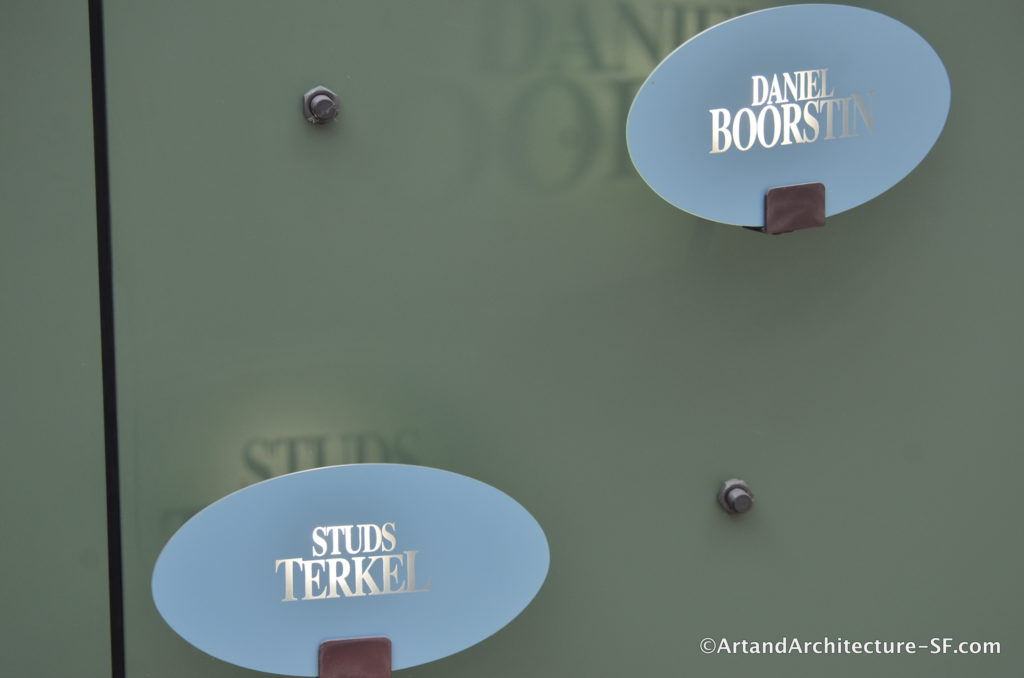 Nayland Blake’s mixed-media work has been variously described as disturbing, provocative, elusive, tormented, sinister, hysterical, brutal, and tender.
Nayland Blake’s mixed-media work has been variously described as disturbing, provocative, elusive, tormented, sinister, hysterical, brutal, and tender.
Blake attended Bard College in Annandale-On-Hudson, B.F.A. from 1978–82 and then moved to California. He attended the California Institute of the Arts, Valencia, M.F.A., from 1982–84.
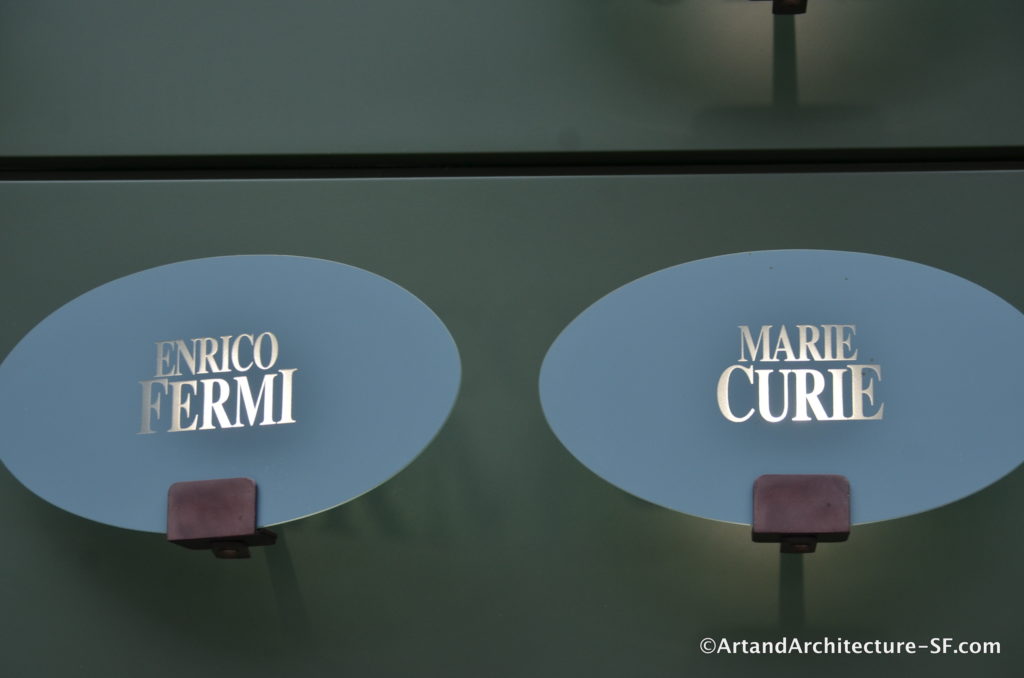 *
*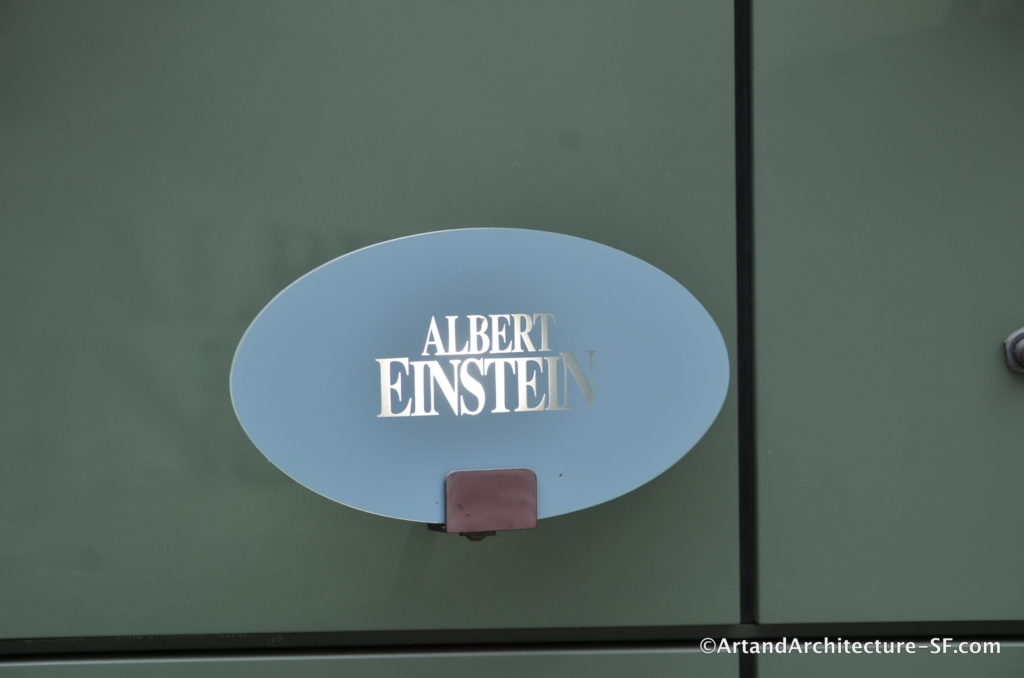 Blake was born in 1960. He began displaying his work in 1985. Among his most famous pieces are a log cabin made of gingerbread squares fitted to a steel frame, entitled Feeder 2 (1998). When it went on display at the Tang Teaching Museum and Art Gallery, visitors nibbled off bits and pieces of the cabin’s interior walls, while the smell of the gingerbread filled the gallery.
Blake was born in 1960. He began displaying his work in 1985. Among his most famous pieces are a log cabin made of gingerbread squares fitted to a steel frame, entitled Feeder 2 (1998). When it went on display at the Tang Teaching Museum and Art Gallery, visitors nibbled off bits and pieces of the cabin’s interior walls, while the smell of the gingerbread filled the gallery.
His work is in the collections of the San Francisco Museum of Modern Art, the Whitney Museum of American Art, the Walker Art Center, and the Des Moines Art Center, among others. He currently lives and works in New York City.
This project was funded with the 2% for Art Program at a cost of $14,000.
Eureka Valley Rec Center
100 Collingwood
Castro
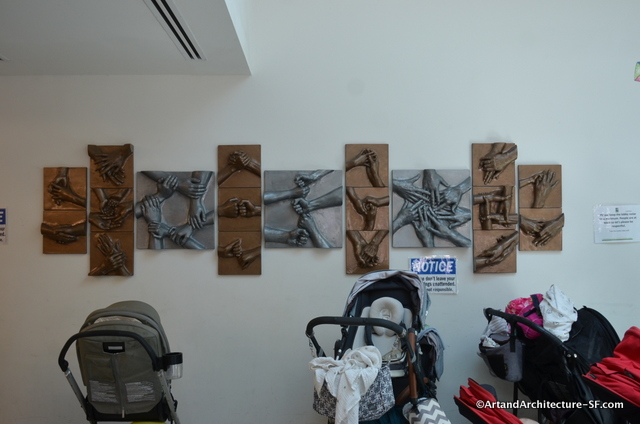
Titled From the Heart Outward, this piece sits in the lobby of the Eureka Valley Rec Center.
The project consists of casts of hands of citizens throughout the neighboring community. The call for volunteers read: “My sense of the center is that it’s a really welcoming place for diverse interests and community groups. I wanted to use the welcoming theme and came up with the idea of using hands and gestures. My plan is to use various groupings–parents and children, friends, couples, partners–doing gestures. They could be holding hands, holding a basketball, playing cards. I expect some people will have ideas better than mine as far as the final gestures used,” says Saulls.
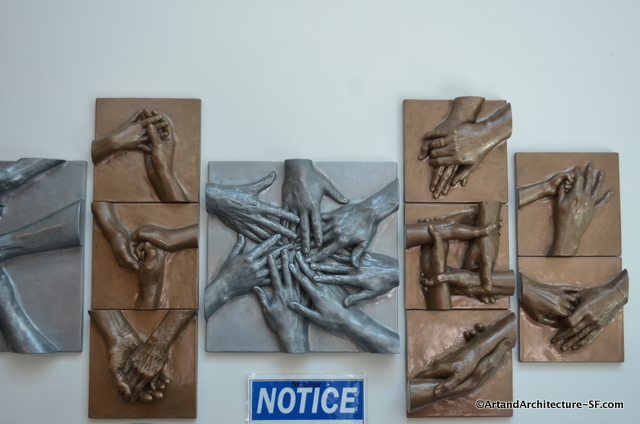
The pieces, cast by Erick Dunn, are of cold cast bronze and zinc aluminum

There are three hands at the entry to the Rec Center. This piece is titled Welcome Hands
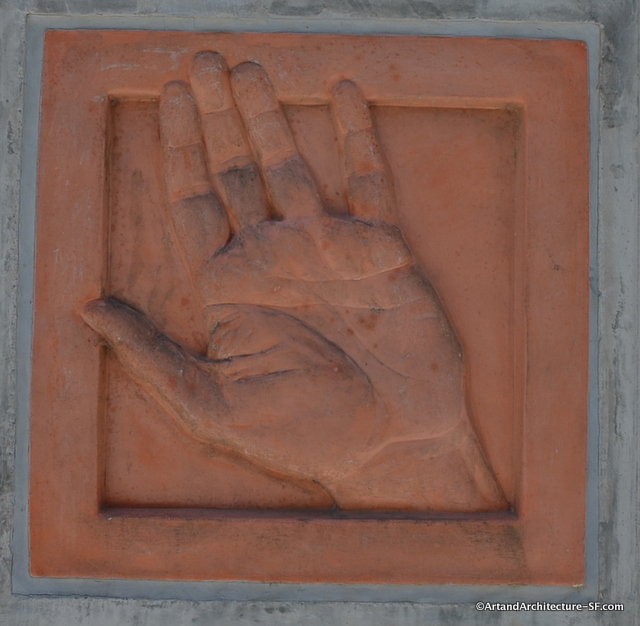
These hands are made of concrete and were cast by Concretework Studio
Vicki Saulls has been on this site several times before.
This project was commissioned by the SFAC at a cost of $42,000 in 2004.
Presently in storage at Golden Gate Park
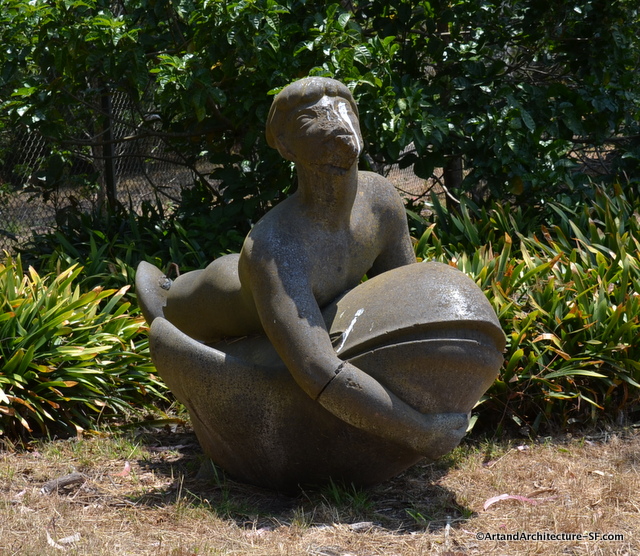
This statue is from the Golden Gate International Exposition. It is by Cecilia Bancroft Graham.
Graham was born in San Francisco, on March 2, 1905. She studied at the California School of Fine Arts, graduated from Mills College in Oakland, and studied sculpture with Oscar Thiede in Vienna, Louis de Jean in Paris, and with Carl Milles at Cranbrook Academy in Michigan. She passed away in Carmel, California in 1984.
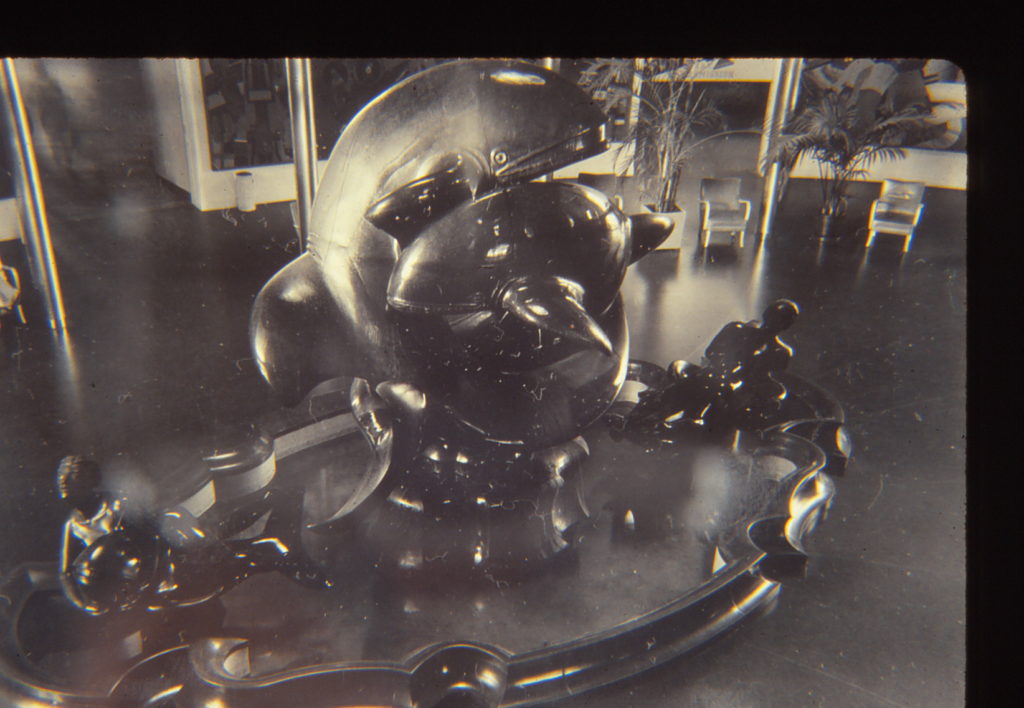
Photo courtesy of Anne Schnoebelen of the Treasure Island Museum.
The statue was placed around the Fountain in the San Francisco Building. The center whales were by Robert Howards.
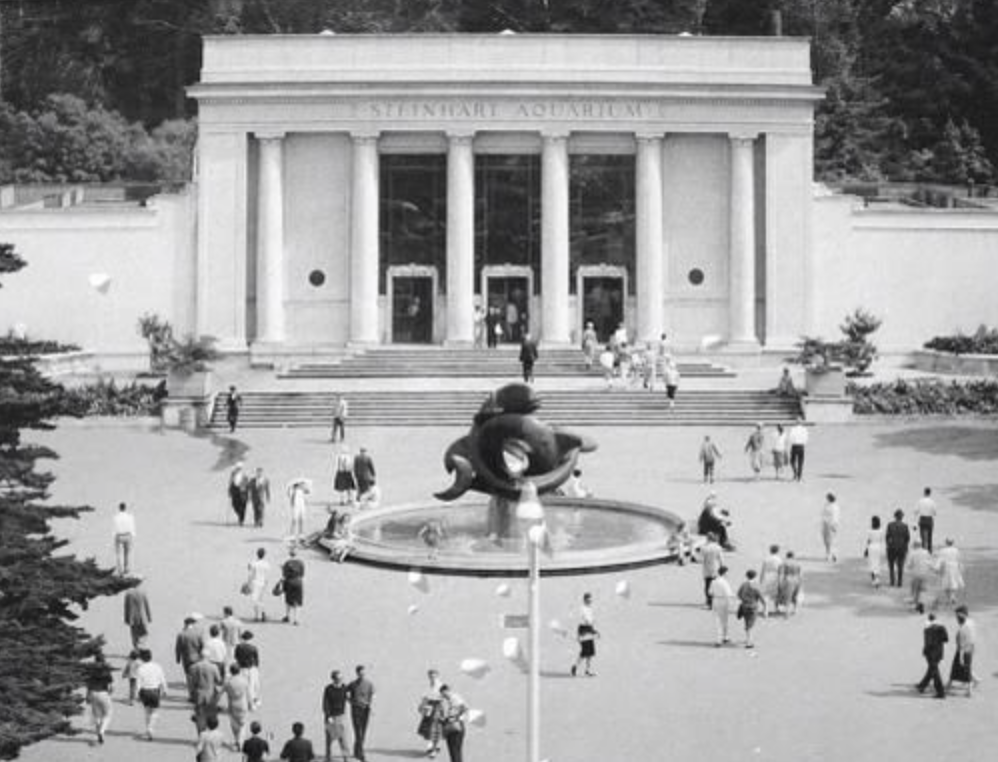 The whales sculpture was moved to a fountain in front of the Steinhart Aquarium, now the Academy of Science, in Golden Gate Park. They are no longer there.
The whales sculpture was moved to a fountain in front of the Steinhart Aquarium, now the Academy of Science, in Golden Gate Park. They are no longer there.
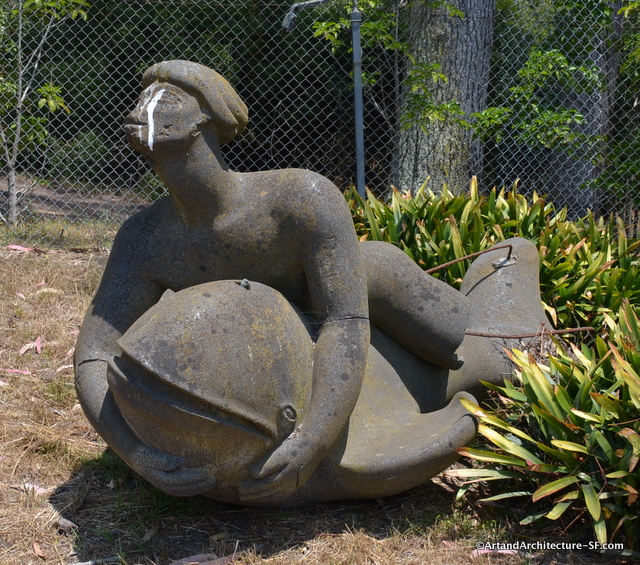
The Dolphin is, sadly, badly damaged.
Thank you to the Landscape department of Golden Gate Park for aiding me in finding the statue.
Chinatown Public Library
1135 Powell Street
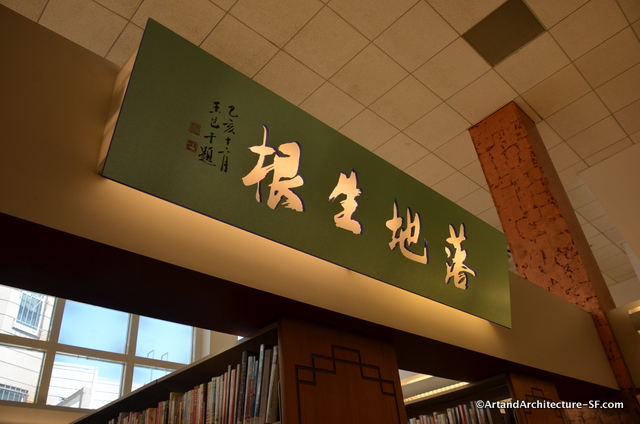
Take Root is a set of bi-lingual panels referencing traditional Chinese salutary plaques in contemporary materials of rear-illuminated, die-cut anodized aluminum. The Chinese text is based on calligraphy written for Take Root by well-known artist and calligrapher C. C. Wang. It features a Chinese-American saying about setting roots in America, that is adapted from a traditional saying about returning to the old country at life’s end. The English text is a poetic translation.
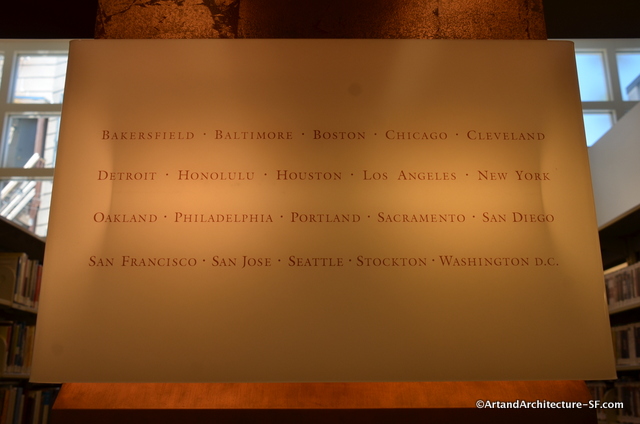 Light sconces bear the names of key departing and arrival cites in Asia and America.
Light sconces bear the names of key departing and arrival cites in Asia and America.
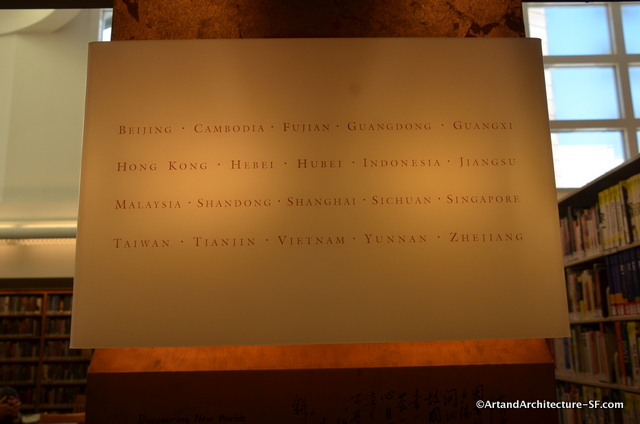
Copper-leafed columns bear copper panels that are etched with bilingual community poems about the library and referencing the immigrant history of the community.
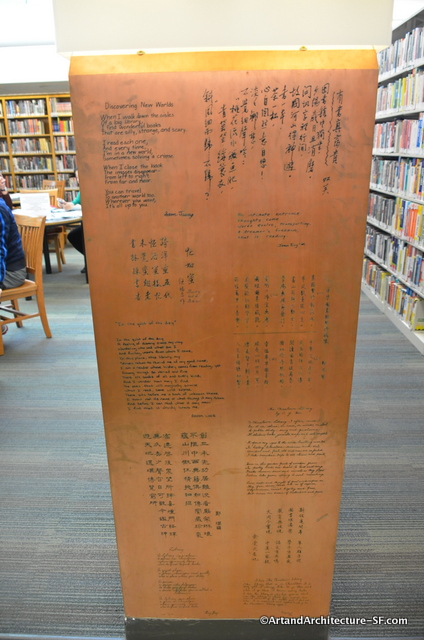
*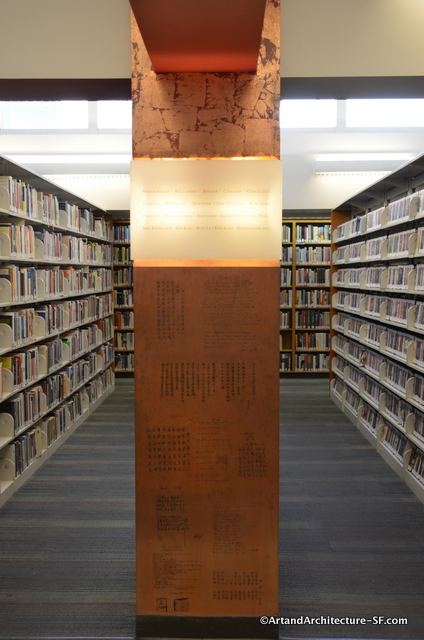
Rene Yung is a visual artist living and working in San Francisco, California. She grew up in colonial Hong Kong before emigrating to the United States. Her work combines visual imagery with text to explore issues of culture and identity. She has exhibited nationally and internationally, including at the Palazzo Giustinian Lolin, Venice, Italy, as part of the 1995 Venice Biennale; Contemporary Arts Museum, Houston, Texas; Center for the Arts, Yerba Buena Gardens, San Francisco; San Jose Institute of Contemporary Art; the Richmond Art Center, Richmond; and other Bay Area institutions.
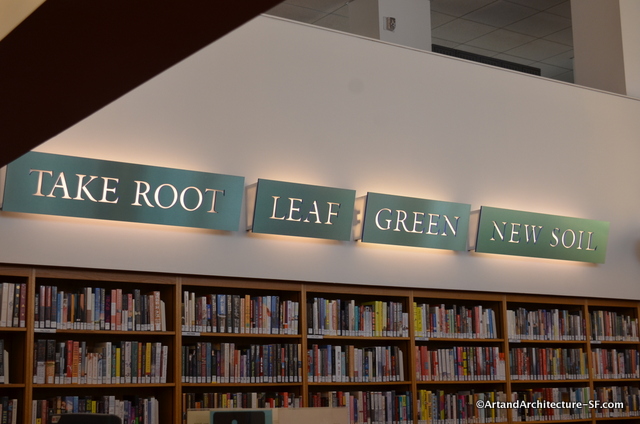
Hallidie Plaza
Market Street
 This Sister Cities signpost was dedicated on June 28, 2018, it was created at the request of interim Mayor Mark Farrell.
This Sister Cities signpost was dedicated on June 28, 2018, it was created at the request of interim Mayor Mark Farrell.
It was a joint effort amongst many departments of the city, Public Works managed the project and installed the foundation, SFMTA made and installed the signs, and the San Francisco Public Utilities Commission provided the pole.

San Francisco’s sister cities include Abidjan, Côte d’Ivoire; Amman, Jordan; Assisi, Italy; Bangalore, India; Barcelona, Spain; Cork, Ireland; Haifa, Israel; Ho Chi Minh City, Vietnam; Kiel, Germany; Krakow, Poland; Manila, Philippines; Osaka, Japan; Paris, France; Seoul, Korea; Shanghai, China; Sydney, Australia; Taipei, Taiwan; Thessaloniki, Greece; and Zürich, Switzerland.

*
Laguna Honda Hospital
Pavillion Atrium
375 Laguna Honda Boulevard
Forest Hill
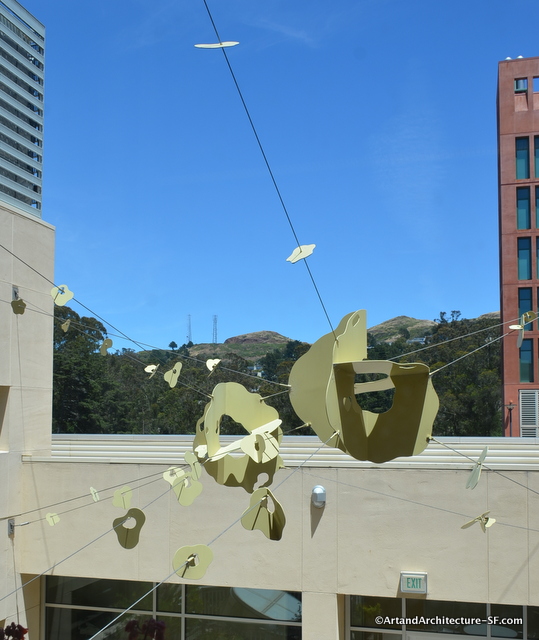
This is Skydancing by Takenobu Igarashi they are painted aluminum sculptures, reminiscent of blossoms and suspended from aircraft cables.
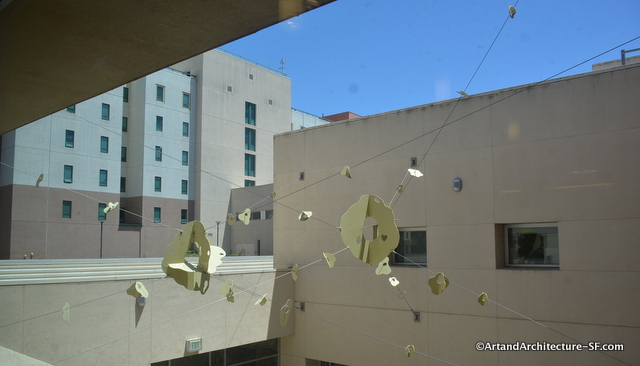 Japanese artist Igarashi has taught at Chiba University and the University of California, Los Angeles (UCLA). He collaborated in the foundation of the Faculty of Design at Tama Art University (Kaminoge Campus) to set up the first computerized design education in Japan and was the first Head of the Design Department.
Japanese artist Igarashi has taught at Chiba University and the University of California, Los Angeles (UCLA). He collaborated in the foundation of the Faculty of Design at Tama Art University (Kaminoge Campus) to set up the first computerized design education in Japan and was the first Head of the Design Department.
In 1994, he ended his 25 years of design activity and moved to Los Angeles to become a sculptor. After working with marble, he discovered terracotta and wood as his material. He returned to Japan in June 2004.
Representative works are in the permanent collection of over 30 museums worldwide including MoMA. He has been awarded the Commendation of the Minister of Foreign Affairs, Katsumi Masaru Award, the Mainichi Design Award, the IF Design Award and the Good Design Award for his achievements and activities in the field of graphics and product design.
Igarashi has been an emeritus professor at Tama Art University since April 2015.
The hospital had a $3 million budget for the artwork within the new wing of the hospital, thanks to the 1% for art requirement in San Francisco public buildings.
The budget for the three pieces provided by Takenobu Igarashi was $238,686
Much of the art at Laguna Honda is not accessible to the general public, so only 2 of Igarashi’s 3 pieces appear in this website.